

How the Viking Octantis Will Offer Sustainable Expedition Cruising
- January 25, 2022
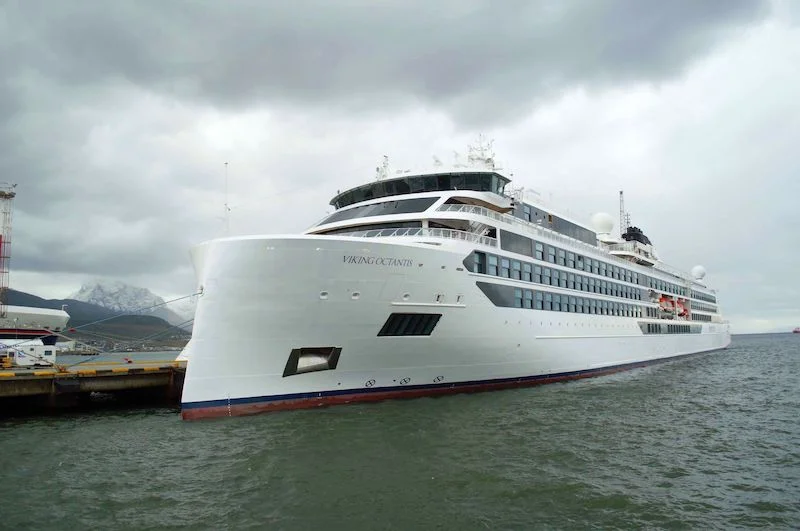
The 378-passenger Viking Octantis, delivered by Fincantieri’s VARD in Norway last month, is scheduled to set sail for the first time in early 2022.
The Octantis has a Polar Class 6 hull that can sail in 75 centimeters of ice thickness.
According to Viking’s New Build Project Manager Luc Martin, the Octantis is at least 36 percent better than the requirements set by the International Maritime Organization.
“That’s what we call EEDI – the energy efficiency design index – which can be summarized as the impact to the environment (divided by) benefit for society,” Martin said in a Viking TV video series .
Martin added that the Octantis has been designed to be ready for zero emissions.
“We also concentrated on the appendices like the bow thrusters, the stabilizers and the pods. The pods has been designed to offer enhanced maneuvering at port and in the fjords, the Arctic or Antarctica. It’s also helping us reduce fuel consumption,” Martin noted, adding that today Viking can reduce fuel consumption by about 4 percent when compared to traditional propulsion.
The Octantis is also using seawater and freshwater to cool down the engines. The heat that is generated by the engines is also not lost.
“We are going to use that heat to either create steam or help the hot water system onboard the ship,” Martin said. “We are also recovering the heat from the exhaust. That heat is also used either for creating steam or hot water.”
Kinder to Wildlife
“We have worked together with IAATO to advocate for a whale-safe speed. Within the geofenced area, we will lower our speed to minimize the risk of colliding with wildlife,” said Viking’s Director for Expedition Operations, Jørn Henriksen.
“The Viking expedition ships will also have a SILENT-E notation within our classification society, meaning that we have a certificate saying exactly how much noise emission we have in the water. And when we go into whale-safe speeds in Antarctica, we can also guarantee that we emit a low noise signature to wildlife in the ocean. Combined with whale-safe speeds, this is a very good way to minimize the impact on marine wildlife,” Henriksen added.
Viking’s Head of Science and Sustainability, Damon Stanwell-Smith, said that the cruise line has worked with the Cornell Lab of Ornithology to reduce the likelihood of harming birds.
“It is always a risk with all expedition ships sailing in remote areas when sailing in places where birds are nesting. In foggy and dark conditions, birds can be attracted to the lights of the ship sailing by and therefore strike the ship accidentally. To reduce this, we’ve worked with our partner, the Cornell Lab of Ornithology, to design a bridge control system that we call Bird Safe Lighting Mode, which reduces the external lights as much as we can to still be safe and reduce the chances of bird strikes,” Stanwell-Smith said.
Kinder to Environment
Additionally, according to Stanwell-Smith, to protect the delicate benthic areas on the seabed underneath the ship while doing off-ship activities, Viking uses dynamic positioning.
According to Stanwell-Smith, one of the two special operations boats on both the Octantis and its upcoming sistership Polaris has been designated a survey vessel.
“It has been built with a state-of-the-art multibeam sonar system. This enables us to scan the seabed, do bathymetric surveys, look at the glacial geomorphology and related research, as well as understand the places that we visit in remote locations better,” Stanwell-Smith said. “This means it has been installed with a state-of-the-art multibeam sonar system. This enables us to scan the seabed, do bathymetric surveys, look at the glacial geomorphology and related research, as well as understand the places that we visit in remote locations better.”
Before we do our first landing in Antarctica, we go through a sequence of cleansing of velcros on people’s gear. We vacuum clean people’s backpacks that they use in other areas of the world, we sanitize the boots and make sure that we minimize the risk of bringing foreign materials with diseases and viruses into the Antarctic food web,” explained Henriksen.
Cruise Industry News Email Alerts
- Breaking News

Get the latest breaking cruise news . Sign up.
54 Ships | 122,002 Berths | $36 Billion | View
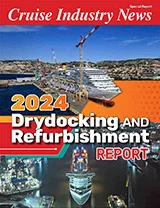
Highlights:
- Mkt. Overview
- Record Year
- Refit Schedule
- PDF Download
- Order Today

- 2033 Industry Outlook
- All Operators
- Easy to Use
- Pre-Order Offer
- Advertising
- Cruise News
- Magazine Articles
- Quarterly Magazine
- Annual Report
- Email Newsletter
- Executive Guide
- Digital Reports
Privacy Overview
- Share full article

Hydrogen-Powered Ships Are Coming. How Green Is Your Cruise?
As cruise companies head into their busiest season, they say they have ambitious plans to curb greenhouse emissions and find cleaner sources of fuel. But critics say the progress is too slow.
Hurtigruten’s hybrid vessel, the MS Roald Amundsen, seen here at Port Miami in Florida, began expedition cruises launched in 2019. Credit... Scott McIntyre for The New York Times
Supported by
By Maria Cramer
- Published Nov. 27, 2022 Updated Dec. 6, 2022
In the Caribbean, many cruise companies have bought islands and turned them into private resorts for the exclusive use of cruise passengers who cavort in enormous wave pools, rush down 135-foot water slides with names like Daredevil’s Peak, and zip-line across wide beaches.
But on Ocean Cay, an island 20 miles south of Bimini that MSC Cruises began leasing from the Bahamian government in 2015, there is no theme park, no giant water slide.
Oh, there are plenty of bars, shops and wave runners. But the general aim is to provide a serene getaway and largely quiet activities — snorkeling, swimming and lounging on beach chairs — while scientists and students from the University of Miami and Nova Southeastern University in Fort Lauderdale research how to reverse the decline in coral reefs and develop reefs that can withstand climate change.
MSC, which has a 100-year lease with the Bahamian government, invested $200 million to transform the island from a barren industrial site that had once been used to mine sand into a 103-acre haven of native plants and trees, surrounded by a 64-square-mile marine reserve.
The island, according to MSC, is the centerpiece of an overall plan to make the company more sustainable. It is only one among a flurry of plans and initiatives cruise companies have been announcing in recent years as they try to convince the public they are serious about combating climate change.

More ideas to escape the cold:
7 New Escapes in the Caribbean : From an off-the-grid tropical hideaway to a reefside diving resort, these new hotels will take you far from anything that resembles snow and cold.
Can Responsible Travel to Hawaii Be Fun? : It turns out that farm stays and eco-friendly snorkeling trips really are more entertaining than sitting on a beach with a mai-tai.
The Key to Vacationing With a Toddler? A Wave-Free Beach : A family-friendly guide to destinations that are basically bathtubs — even in the winter.
Going Local on the Island of St. Lucia : Creole cooking classes, boisterous street parties, a tour of a cacao plantation and visits with islanders preserving local traditions.
How Green is Your Cruise? : As cruise companies head into their busiest season, they say they have ambitious plans to curb greenhouse emissions and find cleaner sources of fuel.
Viking , a luxury line whose passengers tend to be wealthy and college-educated, said it is building ocean ships that will run on hydrogen fuel cells, an investment that its chairman, Torstein Hagen, said will cost the company an additional $40 million per ship. Royal Caribbean Group , a behemoth in the industry which owns three cruise lines, said it will launch a ship in 2023 that will be equipped with “a large-scale, hybrid power source,” a combination of fuel cells, batteries and dual-fuel engines that use liquefied natural gas.
Virgin Voyages , an adults-only cruise line with four ships, has partnered with three companies working on biofuel solutions — from cooking oil to animal or even human waste — that could power its engines in the future.
As the cruise industry continues to recover from the pandemic, addressing climate change and the ways cruising contributes to it has emerged as a major challenge. Industry officials project a “full recovery” from the pandemic in 2023 and as cruises enter the winter season, typically their busiest time of year, a survey of 4,000 people showed that demand for cruise holidays was greater than in 2019, according to the Cruise Lines International Association (CLIA), a trade organization.
It is a comeback environmental groups said they have been dreading.
“If you care about the environmental footprint of your vacation, a cruise is not the first vacation I would choose,” said Marcie Keever, director of the Oceans and Vessels Program at Friends of the Earth , an environmental organization that among other things, grades cruise ships on their green practices. “I don’t even know if it would be the second or the third.”
Cruise ships represents 0.6 percent of total travel carbon emissions, the least of any sector of the travel industry and far less than aviation, which represents 17 percent of carbon emissions, according to the World Travel and Tourism Council.
But most cruise companies still rely on heavy fuel oil , a dirty, but cheap fuel, to help power the engines of behemoth ships that carry thousands of people around the world. Finding an energy source that will both reduce pollution and greenhouse gases remains the biggest obstacle to the industry reaching a goal CLIA announced in 2021: to reach net zero carbon emissions by 2050 and, as an intermediate step, reduce emissions 40 percent by 2030.
“This is the biggest challenge that the industry will face in maritime history for sure,” said Linden Coppell, the vice president of sustainability at MSC Cruises. “Nothing is off the table for us for now as we look for new solutions.”
But the industry’s continued reliance on heavy fuel and the plans of many cruise lines to transition to liquefied natural gas — a cleaner, less polluting fossil fuel that also emits methane, a major greenhouse gas — have led to doubts over how serious companies are about fulfilling their pledge.
“There is a lot of greenwashing,” said Sönke Diesener, the transport policy officer at the Nature And Biodiversity Conservation Union in Germany (NABU), an environmental organization that studies the industry and ranks cruise companies according to their sustainability plans.
“If you still burn the most toxic fuel on Earth,” he said, “it doesn’t matter if your customers don’t sip drinks from plastic straws.”
A pact to get to zero
Cruise companies do not get enough credit for the steps they are taking and the improvements they have already made to ships, said Anne Madison, a spokeswoman for CLIA.
More than 15 percent of vessels scheduled to launch in the next five years will be equipped with engines that can be powered with fuel cells or batteries. Eighty-five percent of the ships being built in the next six years will be able to plug in to shore terminals and use electricity when they are docked, rather than having to keep their engines running the entire time they are in port and burning fuel.
“The commitment is clear,” Ms. Madison said. “The effort is aggressive. The path is complicated and full of challenges.”
Among those complications is the pace of technology and the debate among cruise lines over which fuel to use.
CLIA has touted liquefied natural gas as a cleaner alternative fossil fuel than heavy fuel that can act as a stopgap until a more sustainable energy source becomes available.
But environmental groups said methane , the primary component of natural gas, traps even more heat in the atmosphere than carbon dioxide emitted from heavy fuel.
“LNG is totally a false solution,” said Ms. Keever of Friends of the Earth.
Industry officials say that concerns over methane are antiquated and do not take into consideration technological advancements that have reduced the levels of methane that escape into the atmosphere.
Still, said Mr. Diesener of NABU, a better, temporary alternative is marine gas oil, which is similar to car diesel, but does not carry the methane risks and is far cleaner than heavy fuel oil.
Cruise lines are also investing in vessels that can operate on shore-side electricity when they’re at port, using berths as plug-in stations instead of running their engines, which emits tons of carbon dioxide. A single cruise ship docked for one day can emit as much diesel exhaust as 34,400 idling tractor-trailers, according to an independent analysis verified by the Environmental Protection Agency.
But only about 2 percent of ports worldwide — 29 of them, including eight in the United States — offer shore-side electricity, Ms. Madison said.
Twenty more cities and communities are planning to offer shore power, including in the Florida Everglades and Miami, but “these installations are expensive, and they require public-private funding,” Ms. Madison said. Royal Caribbean and Carnival Corporation , two of the world’s biggest cruise lines, which together own more than 150 ships, announced in November that they would work with the port of Galveston, Texas, to develop a plug-in station.
Cruise lines have also been criticized for their contributions to overtourism, especially when large ships dock in fragile places like Dubrovnik or Venice and send a flood of thousands of passengers ashore, overwhelming destinations.

When residents of U.S. port towns have voted for restrictions to control the crush of passengers coming into their communities or protect national parks and natural resources, state governments have rolled back their efforts. In 2006, Alaska voters approved the Ocean Ranger program , which used state funds to pay for inspectors to make sure cruise ships going into places like Glacier Bay National Park and Preserve were complying with state environmental and health laws.
Governor Mike Dunleavy, a Republican, defunded the program in 2019.
In November 2020, residents of Key West, Fla., voted by a more than 60 percent margin to restrict the number of cruise passengers allowed in the city to 1,500 per day. But eight months later, Governor Ron DeSantis reversed the decision when he signed a law that voided any local referendum or initiative that restricts maritime commerce.
In both cases, CLIA opposed the local efforts, balking at a proposal to have a tax on cruises to help pay for the Alaska program and contemplating supporting litigation or legislation that would pre-empt ship bans like the one in Key West. Ms. Madison said that CLIA did not lobby against the local efforts and that the group and its members “cooperate with cruise destinations to support their tourism management needs.”
Cruise companies should support such voter initiatives, which are aimed at preserving tourist destinations their passengers want to visit, Ms. Keever said.
Under the current way of doing business, she said, “the places that they depend on for their business model are going to disappear.”
Does greener = more expensive?
Below the deck of the MS Roald Amundsen, which in 2019 became the first hybrid cruise ship to set sail, are two enormous battery packs. They are each about four yards in length and help power the four-engine vessel, which also relies on marine gas oil.
The technology reduces the ship’s fuel consumption and carbon emissions by 20 percent, according to Hurtigruten Expeditions, the Norwegian company that owns it and has developed climate protection measures that usually send it to the top of rankings by groups like NABU .
The ship is one of Hurtigruten’s four vessels that run on hybrid power. Two other ships will be upgraded by early 2024 to run on hybrid power and five others will be outfitted with selective catalytic reduction systems that would cut emissions by 80 percent, according to the company.
“We don’t speak about zero emissions in 2050,” said Daniel Skjeldam, the chief executive of Hurtigruten Group. “We say that our target is to have the first ship with zero emissions by 2030.”
Traveling on the Amundsen is not cheap.
A 13-day Caribbean cruise in April on the ship, which carries about 530 people, starts at $4,547 per person. A similar trip on the MSC Divina, which carries up to 4,345 passengers and runs on heavy fuel oil, starts at $1,700 for two people.
It’s expensive to take passengers to remote places like the Galápagos and Antarctica while adopting new technology that cuts emissions, Mr. Skjeldam said.
“Customers must be aware of this when booking their travel,” he said. “Just as they would by choosing an organic product in the supermarket, they must be willing to pay a little more for a more sustainable and responsible travel experience.”
Owen O’Shea, a marine research program manager at the MSC Foundation, the philanthropic arm of MSC, said he knows most passengers do not book with MSC to support coral reef restoration.
“I don’t think people choose to cruise with MSC because of the sustainability goals,” he said. “It’s mainly people who want to get away for a few days on a cost effective break.”
Do passengers care?
That was true of many of the passengers on the MSC Meraviglia, who went on a three-day cruise around the Bahamas in September that left from Port Canaveral and stopped for a day at Ocean Cay.
Carole Sincic, a dental hygienist from Orlando, Fla., said a cruise line’s sustainability plans are not a priority when she is planning a vacation. Her focus, she said, is on “what is the easiest, cheapest way” to cruise.
Ms. Sincic, 69, compared spending more to cruise on a ship with a hybrid engine to buying an electric car — it’s a nice idea but she cannot afford it.
“I’m not rich,” she said. “I don’t have the ability to absorb the extra costs and the extra hassles.”
In surveys, cruise passengers say they do care about sustainability. A recent poll by Cruise Critic, a cruise review website, found that 61 percent of respondents said they are “very concerned” about the impact cruises have on the environment, said Aaron Sanders, a senior editor at the site. “But it’s not impacting their booking decisions yet,” Mr. Sanders said.
Cruise lines recognize that more passengers are scouring environmental sites to see how cruise companies rank, said Robert Kritzman, a partner at Clyde & Co., an international law firm in Miami, who advises cruise companies and spent 13 years as general counsel for Norwegian Cruise Line.
“People save up for a vacation and you have to deliver a product that you think is worthwhile,” he said. “Cruise lines are very, very sensitive to the negative publicity.”
Ms. Sincic, the dental hygienist, said her visit to Ocean Cay changed her thinking about what to prioritize when booking a cruise.
She met with Dr. O’Shea during her visit to the island and listened carefully as he described how the restoration of the island appeared to be drawing stingrays, sea turtles and even woodpeckers.
She visited one of Ocean Cay’s beaches and was moved when she heard the story of a staff member who found heavy tracks in the sand while putting out lounge chairs early one morning. A sea turtle had laid eggs there the night before. The staff members quickly alerted researchers, who placed posts around the small patch of sand and a sign warning beachgoers to keep away.
“I’d book because of this island,” Ms. Sincic said. “I was going to go on a cruise. I might as well go on a ship that helps something.”
Follow New York Times Travel on Instagram , Twitter and Facebook . And sign up for our weekly Travel Dispatch newsletter to receive expert tips on traveling smarter and inspiration for your next vacation. Dreaming up a future getaway or just armchair traveling? Check out our 52 Places for a Changed World for 2022.
Maria Cramer is a reporter on the Travel desk. Please send her tips, questions and complaints about traveling, especially on cruises. More about Maria Cramer
Come Sail Away
Love them or hate them, cruises can provide a unique perspective on travel..
Cruise Ship Surprises: Here are five unexpected features on ships , some of which you hopefully won’t discover on your own.
Icon of the Seas: Our reporter joined thousands of passengers on the inaugural sailing of Royal Caribbean’s Icon of the Seas . The most surprising thing she found? Some actual peace and quiet .
Th ree-Year Cruise, Unraveled: The Life at Sea cruise was supposed to be the ultimate bucket-list experience : 382 port calls over 1,095 days. Here’s why those who signed up are seeking fraud charges instead.
TikTok’s Favorite New ‘Reality Show’: People on social media have turned the unwitting passengers of a nine-month world cruise into “cast members” overnight.
Dipping Their Toes: Younger generations of travelers are venturing onto ships for the first time . Many are saving money.
Cult Cruisers: These devoted cruise fanatics, most of them retirees, have one main goal: to almost never touch dry land .
Advertisement
Sustainability Report 2021
Sustainability Report 2021 For a safe and responsible world
Download PDF fil
Hot Topic: Surprise Cruise Reveal Ideas

Cruise Sustainability: Who Leads the Way to a Better Future in Travel?
Cruise sustainability is of the utmost importance in travel. Is it not just the responsibility of cruise lines but also its guests to be better friends to our environment, and stewards of the Earth when we travel?
We can all work together to build a better future for the planet and (believe it or not) the cruise industry helps lead the way.
Disclosure: There are affiliate links in this post, which means we may earn a small commission if you click the link and proceed with a purchase, at no cost to you . We truly only recommend hotels, products, and services we personally use. As Amazon Associates, we earn from qualifying purchases.

Cruise Sustainability is Two-Fold
There are cruise companies that focus on sustainability when thinking of their ships' designs, their impact on the Earth's waterways, and their guest programming. In fact, you'd probably be hard-pressed to find one that doesn't focus on this in the 21st century. This is one piece of sustainable cruising.
The other is passengers. We can all do more to be eco-conscious travelers and guests of cruises.
What can guests do to make cruising more environmentally friendly?
Anyone who lives on the planet (and that's all of us) should want to take an active role in taking care of it. The onus isn't 100% on the cruise lines when these ships and experiences are created for the enjoyment of their passengers.
As such, travelers can be environmental advocates on board and at home.
Keeping sustainability in mind on cruise ships may mean that you don't ask for new towels every day because of the energy it takes to provide new ones and wash the old ones more often than necessary.
Bringing your own reusable water bottle or reusable straw helps cut down on waste. You can also support local economies in your cruise choices by booking through one of the cruise companies that are sustainability-focused. In fact, we mention some below.) Or book an itinerary that stops at a port that supports locals, like at native-Alaskan-owned Icy Strait Point .
Everything on the Earth is connected. If you recycle at home, for instance, you're likely helping reduce plastics from entering the ocean.
Something as simple as using Nespresso's recyclable coffee pods instead of Keurig's mostly non-recyclable coffee pods helps. (Nespresso even provides free bags to ship the pods back to them to properly recycle.) Or you can shut off the water when you brush your teeth to conserve it.
It's simple to invest in a reusable water bottle from home and stop purchasing bottled single-use plastic bottles in bulk. (We love our MiiR bottles that give back to the Earth when you make a purchase. Use code SOMETIMESHOME for a 15% discount.) These are only a few ideas of many to help save the planet from home .
There are many more ways to aid in sustainability when you sail.
What can cruise lines do to be more sustainable?
Sustainability initiatives for cruise lines are multi-tiered:
- Are the cruise ships fuel-efficient, with low emissions?
- Do they use the latest technology in their engines, propellers, and the like?
- Do they have recycle programs and proper waste-management onboard? How are they helping to reduce pollution?
- Are they eco-conscious when it comes to material items for guests? This can include anything from linens made from sustainable materials, produced in humane factories, to locally made bath products in cabins.
- Do they care about the environment (including all its creatures) in the ports they visit and their local economy?
- Are their excursion options environmentally responsible?
- Do they have a sustainable food program on board or source local ingredients?
- Do they donate to charitable causes or foundations?
These are just some of the considerations that make a cruise sustainable or not. Many cruise lines also have sustainability statements , which is something to look for when considering booking a cruise. (Unfortunately, they're not always easy to find and not every cruise line has one.)
We go into detail about some of the cruise lines leading the way in cruise sustainability below.
Are cruises safe for the Earth?
The earth is our precious planet. Just as we only have one life to live, we only have one planet and we need to protect it.
Sustainability is always at the forefront of our minds as we live each day whether or home or while we travel. We are always asking ourselves, “How can we reduce, reuse and recycle?” And when we write about cruises this concept and question remain of the utmost importance.
Can an eco-conscious traveler love cruising and find eco-friendly cruise lines? The answer is yes.
Why it's Important for Cruise Ships to Sail our Oceans, Rivers, and Lakes
People often cannot grasp the importance of a destination, or concept, until they have experienced it themselves.
On a simple level, one cannot understand the majesty of a giraffe, for example, until he or she has seen one in person. And the truth is, most people will never have the privilege of traveling to Africa to see one. Yet, many people have seen a giraffe in person because they have visited an accredited zoo, such as the San Diego Zoo, or Animal Kingdom at Walt Disney World.
A real-life experience has given this person an appreciation for (and hopefully respect for) this animal. As such, people gain a greater understanding and respect for our oceans when they travel on them to remote places where cruise ships take passengers.
Real-World Experiences Help People Respect the Earth
Watching an educational television program is one thing. But a human connection and bond is solidified and taken to new heights when people experience something for themselves, in person.
An example is traveling to the Galapagos Islands. Cruise ships take passengers to the Galapagos, where they learn about Blue-Footed Booby birds, or Galapagos Land Iguanas. Their firsthand experience gives them a love and passion for this wildlife. In turn, they are more inclined to protect it.
Perhaps these people simply tell their friends about it, then their friends are intrigued to learn more. As a result, those friends travel to the Galapagos Islands and are inspired to donate money to help protect the Galapagos Marine Reserve after their experience. Perhaps this family traveled with their college-aged student who changes her major to Marine Biology after her trip, in hopes of getting a job when she graduates working in marine conservation.
None of that would have happened if cruise ships didn't carry passengers to these magnificent regions of the Earth. How else would the average person be able to reach a location such as the Galapagos Islands?
Be a Part of the Change
Therefore, the answer isn't stopping cruise ship travel, just like we won't stop air travel because plane emissions are bad for the environment.
Instead, we need to be a part of positive change in cruise sustainability. Responsible travelers can seek out responsible cruise lines doing good for the Earth and book them over a cruise line that isn't focused on sustainability. (Money talks.)
Cruise Lines have a Bad Environmental Reputation
We are shedding light on wonderful small cruise options that are trailblazers in cruise sustainability.
Cruises may have a bad reputation but let us, for a moment, compare them to other modes of transportation with emissions, like airplanes and cars. Whereas the automobile industry has made strides to move towards electric power, for example, so has the cruise industry. Heck, even the boating industry should be examined more than the cruise industry. Many boaters simply throw waste overboard, shameful as it may be.
Several cruise lines are paving the way for sustainability and have a more neutral environmental impact than ever before.
Impact of Mega Cruise Ships and Small Cruises on Environmental Change
We'd be remiss not to touch on the difference between large ships and small ones.
We primarily prefer small ships like river cruises , yacht cruises , and expedition cruises , which usually tend to have a smaller environmental footprint due to the number of passengers on board (crew and guests) and size of the vessel. Thus, they produce less waste.
While some smaller cruise lines have pioneered what it means to cruise a sustainable vessel with sustainable programming (such as Maple Leaf Adventures, who has always had sustainability as a guiding light in their company values), large cruise lines have followed suit.
We were thrilled to learn that Royal Caribbean has a Chief ESG Officer (Environmental, Social, and Governance), helping to keep cruise sustainability at the helm of the company's initiatives. MSC even has a Director of Sustainability.
What does cruise sustainability mean?
To us, sustainability is a verb. It is conservation in action. It can manifest itself in a myriad of ways, from responsible tourism and caring for ports cruise lines travel to, to passenger education about the environment onboard and off, to donating to good causes and programs.
Hurtigruten Expeditions: Battery-Hybrid Powered Cruise Ship
Hurtigruten uses the UN Sustainable Development Goals as its framework for sustainability. Back in 2012, incoming Hurtigruten Group CEO Daniel Skjeldam (who is CEO today) put an end to the use of heavy fuel oil in the Hurtigruten fleet. Aban on single-use plastic followed. A focus on sustainability continued to be a pillar of Hurtigruten cruises; they remain a leader in cruise sustainability.
Battery-Hybrid Powered Cruise Ships in the Hurtigruten Fleet
MS Roald Amundsen – a battery-hybrid-powered expedition cruise ship- was introduced by Hurtigruten in 2019. An identical expedition sister-ship called MS Fridtjof Nansen followed a year later. Its cutting-edge technology made it possible for a 20% reduction in the ship's fuel consumption and CO2 emissions.
In the fall of 2021, MS Fridtjof Nansen was named the safest and most sustainable cruise ship in the world by Scope ESG Analysis, in partnership with Stern current affairs magazine. The accolade followed Scope's study of 400 cruise ships' safety and sustainability. The evaluation examined things like waste disposal, emission and water purification systems, and limitations on operations.
MS Fridtjof Nansen and MS Roald Amundsen are equipped with battery packs that enable electrical hybrid propulsion, shore power connection (which eliminates emissions in ports), and revolutionary green technology.
Hurtigruten introduced a third battery-hybrid ship in 2021: MS Otto Sverdrup.
These small expedition ships (with a capacity of between 500-530 guests depending on the destination) were designed to sail our planet's spectacular waters to reach destinations on many people's bucket lists, such as Antarctica, Alaska, the Arctic, and the Norwegian coast.
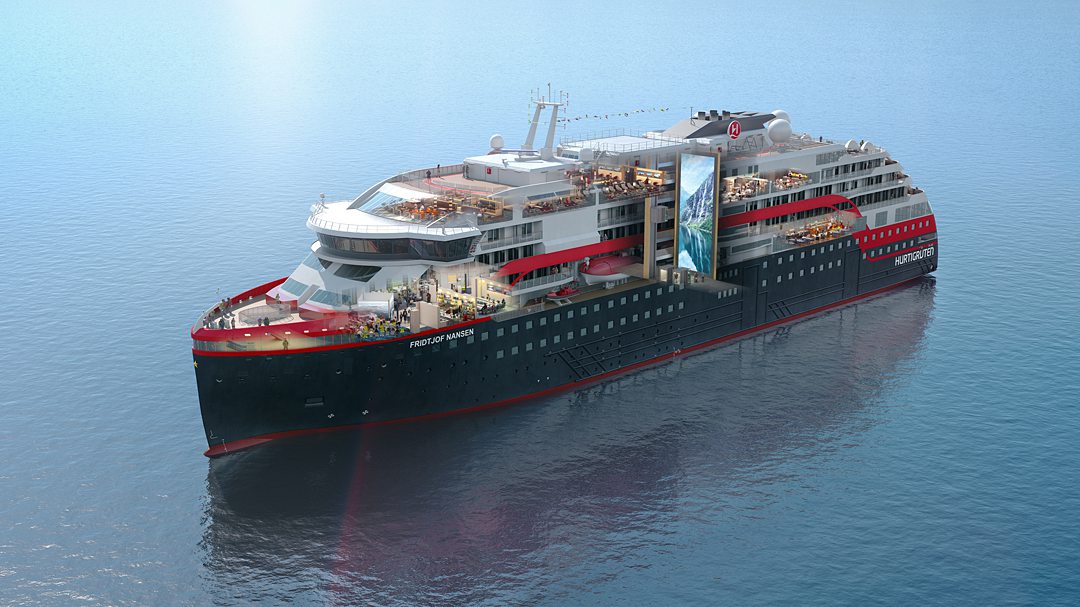
Hurtigruten Leads the Way in Sustainable Cruising
Hurtigruten's cruise ship fleet continues to grow. In addition to its battery-hybrid powered ships, they are focusing on upgrading ships that have been in operation for years.
Three of their Norwegian Coastal Express ships will receive battery pack upgrades beginning in 2022 with completion in 2023: MS Nordnorge, MS Nordkapp, and MS Polarlys. (MS Vesterålen was upgraded in 2019.) Certified biofuel will be used to further reduce CO2 emissions.
These upgrades will reduce NOx (nitric oxide) emissions by a whopping 80%, and CO2 (carbon dioxide) emissions by 25%. When that is done, Hurtigruten's seven coastal express ships will all have emissions equivalent to Tier III, which is the strictest international standard for NOx emissions.
In addition to this, as if it wasn't already a huge (yet important) undertaking to upgrade these ships, they will receive additional upgrades. This includes new propeller blades, hull optimization, a new bulbous bow, new gears, generators, and new control systems.
(For any engineering or ship-building nerds out there, Kongsberg Maritime will be working on the upgrades and is responsible for the design work. Myklebust Yard – a Norwegian shipyard – will do the upgrades of the first two ships.)
Additionally, Hurtigruten Svalbard launched a series of initiatives including partnering with Volvo Penta to run a hybrid day cruiser for guests in Norway.
More Good from Hurtigruten
Another thing we love about this cruise company is its Hurtigruten Foundation.
The foundation's three main goals guide their efforts:
- Preserving endangered wildlife.
- Battling plastic waste and marine litter.
- Supporting local and global projects in the areas where they operate.
As such, they donate resources (including money) to projects like the Galápagos Conservancy to save Petrels birds from extinction, the Association of Greenlandic Children to help build a better future, and South Georgia Heritage Trust to help save rare species of birds.
Aurora Expeditions: 100% Carbon Neutral
The founder of this Australian-based cruise company, Greg Mortimor, is an adventure-driven explorer with a passion for the environment. As such, the first ship was named after him.
Subsequently, the company has made a commitment to naming its ships after living people who have made a positive impact in science and in the environment. The second ship was named after legendary ocean conservationist, Dr. Syliva Earle. She's been quoted on the ocean countless times and her studies and work led to Time Magazine voting her as their first-ever “Hero of the Planet: in 1998.
She was also the first female chief scientist at the National Oceanic and Atmospheric Administration (NOAA) and led the first all-female aquanaut research team. Needless to say, she is certainly worthy of an Aurora Expeditions ship being named after her!
This cruise line even buys eco-friendly supplies for their head office in Australia, where cruise sustainability is a pillar of their focus as they look towards 2022 initiatives . This includes working on a sustainable food program and continuing on the path to being a Certified B Corporation.
Aurora Expeditions Ships
Aurora Expeditions does more for cruise sustainability than simply choosing thoughtful names for their ships. For instance, many of their itineraries will travel to Mission Blue spots. The main goal of Mission Blue is to regenerate oceans and their delicate ecosystems, which are vital to the oceans' health. In 2023, Dr. Sylvia Earle is leading guests on an Antarctic Climate Expedition aboard the 100% carbon neutral cruise ship named after her.
Guests will enjoy entertaining lectures from remote area specialists during every journey, which will expand their knowledge of where they are visiting. Passengers who want to dig deeper into science during their vacation can visit the onboard Citizen Science Centre.
Aurora Expeditions ships focus on low energy consumption, high fuel efficiency, and low vibrations in the water, which minimizes a ship's impact on sea life. Another really cool thing on their ships is a desalination plant, which converts seawater to freshwater.
Aurora Expeditions' “Travel for Good” video is very moving:
Maple Leaf Adventures: Pioneer in Cruise Sustainability
This Canadian-based small ship cruise company is truly a leader in sustainability, which was one of its founding principles. They always lead their trips with an eco-tourism foot forward, respecting nature and the environment.
Maple Leaf Adventures has won countless awards, including Canada's Best Eco-Adventure Tours, Best Boutique Cruise Line, and Business of the Year from Greater Victoria.
The footprint of this small company remains at a minimum. They pay all applicable fees to access parks they visit and obtain permits as needed, and also work in collaboration with the First Nations of the area. Additionally, they donate to charitable causes that help the environment.
Small Company that Gives Big
When Maple Leaf Adventures donates money, they go beyond simply writing checks. Their team members also contribute their time and energy to various associations that are responsibly improving our impact on the planet, like the Wilderness Tourism Association. They are co-founders of the Commercial Bear Viewing Association and Gwaii Haanas Tour Operators Association. They're also are certified GOLD (top-level) by Green Tourism Canada.
They were the first cruise line to be a part of 1% for the Planet , a collection of businesses, individuals, and organization that helps combat environmental issues. (Stasher Bags, our favorite alternative to Ziploc bags and other single-use plastic bags, that have many uses on a cruise , also gives to 1% for the Planet.)
Check out Maple Leaf Adventures' video, pledging to donate $100,000 to the conservation of the Great Bear Rainforest over 10 years:
Maple Leaf Adventures' Small and Sustainable Ships
They have three small ships for guests to choose from Maple Leaf (sailing ship), Swell (tugboat), and Cascadia (catamaran). They accommodate 8, 12, and 24 guests, respectively. Maple Leaf and Swell were built in the early 1900s and Maple Leaf Aventures maintains them as Canadian artifacts, educating their guests and the public on their history.
Maple Leaf Adventures sails along the coast of Canada and Alaska, bringing guests into remote and stunning locations bigger ships simply can't reach. They do so while paying the utmost respect to the landscapes and organisms that live there, big and small.
This is the cruise line for you if you want to stay within North America, getting up close and personal with nature (while keeping a respectable distance from the wildlife, of course). You'll find their unique itineraries explore Canadian regions you've probably never heard of but whose beauty will blow your mind nonetheless.
Kontiki Expeditions: Responsibly Cruising the Ecuadorian Coast
This yacht cruise company is a newcomer to the cruise world. They sail in Ecuador, a country famous in part for the Galapagos Islands. However, they're doing things differently, starting with sailing the coast of this beautiful South American country's mainland. They believe actions – big and small – can positively impact and preserve our environment, and they actively participate in such. Including connecting their cruisers with a stay in a sustainable boutique hotel pre or post-cruise in Quito.
Sustainability is a defining value for Kontiki Expeditions. Environmental policies, gender equality, and fair wages are things they keep top of mind, along with serving Ecuadorian communities. They have partnered with Fundación Real Madrid in coastal Ecuador for years to help improve education and opportunities for children.
Furthermore, they are working with three local communities to help provide schools and education for adults. They assist in teaching managerial skills, connect them with businesses to sell handcrafted products, provide technical support, teach English so they can communicate with visitors, and guide them in entrepreneurship.
Kontiki Expeditions is on the path to becoming a Certified B Corporation by October 2022 and is proud to be a business doing good for the planet. They are also in the process of becoming certified for Green Project Management for cruise sustainability.
As members of the Mingas Por El Mar Foundation, they help clean up Ecuador's beaches and educate the community about the benefits of reducing, reusing, and recycling. They couple this with teaching people ways to minimize our environmental impact along the coast which in turn helps our oceans.
Sustainability On Board Konitiki Expeditions' Yachts
Kontiki Expeditions' yacht ships are low impact, accommodating only 18 passengers per sailing in nine cabins.
They thoughtfully place sustainable decor into each cabin. Handknitted PET silk rugs adorn the floors, created from recycled bottles. Sheets that are on their beds are created from certified sustainably sourced cotton. Even the snacks in guest cabins are organically sourced.
In common areas of their ships, they encourage refilling a reusable water bottle. If you don't travel with your own reusable straw, they have biodegradable straws onboard.
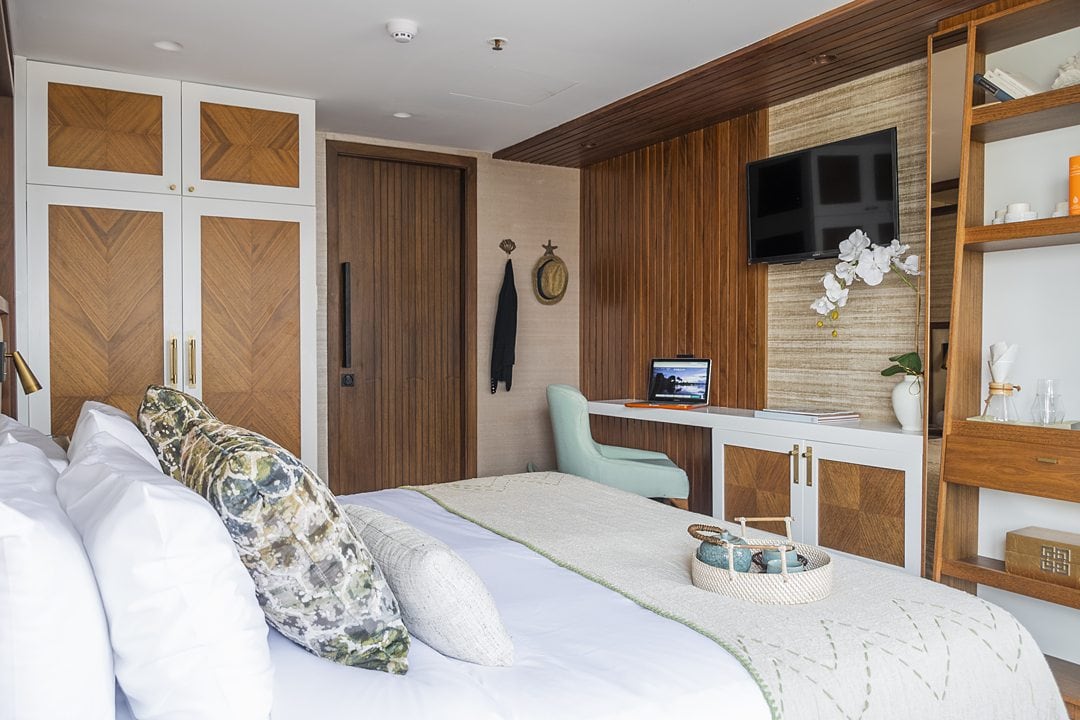
Kontiki Expeditions Excursions Educate and Connect
Their excursions bring guests up close and personal with locals and nature. For example, a stop to speak with and learn from local fishermen at Monpiche Reserve reveals how Ecuadorian people respect the mangroves and can responsibly farm local shellfish for sustainable “Ceviche de Concha” onboard.
Imagine meeting local craftspeople in Pacoche Wildlife Refuge, who show you how they create famous Toquilla hats from plant fibers. Such a tour supports keeping this historic craft alive, which has been added to UNESCO's Intangible Culture Heritage list.
We recommend booking an Ecuador Kontiki Expeditions cruise if you're interested in exploring South America by sea. Guests will enjoy their yacht cruise ships' way of exploration, an amazing crew-to-passenger ratio, and desire to support the local economy, including Ecuador's national parks and reserves.
Viking: Leader in Cruising Making Strides towards a Sustainable Future
Viking , a well-known name in cruising and industry leader, focuses on sustainability. In particular, they have a notable new ship making impressive advancements in this arena.
The Viking Octantis is an expedition ship with cruise sustainability as a main focus of its design. It will sail in the Arctic and Antarctic .
The ship features things passengers would never even dream of considering! And luckily, they don't have to as vacationing guests. Yet nonetheless, it's great for everyone (passengers and crew) to be aware of these things when choosing a cruise line to support.
Such things include:
- State-of-the-art multibeam sonar systems help the ships scan the seabed. This assists in better understanding the science of the places they visit.
- Whale-safe speeds, so the ship does not disrupt these incredible creatures.
- Renewing energy onboard, so not even the heat emitted from their engines goes wasted.
- Enhanced bow thrusters, stabilizers, and pods, which allow them to cut down on fuel consumption.
- Certified low noise emissions, so they do not disrupt the whales' ecosystem.
Mega-Ships Focus on Sustainability
We mention smaller ships in detail because we're small cruise focused at Sometimes Sailing. However, we cannot ignore the efforts of cruise industry giants, whose mere organizational size and budgets you cannot ignore, especially when it comes to cruise sustainability initiatives.
As such, we want to mention a few notable cruise lines and their research, donations, and systems that have helped cruise sustainability advance in considerable ways.
Celebrity Cruises: Healthy Oceans Benefit Everyone
Healthy oceans benefit their business, from guest enjoyment to places they can visit and beyond. But healthy oceans really benefit us all. When you sail with Celebrity Cruises , you may not realize the things onboard their ships that contribute to cruise sustainability and a healthier planet, but they're hidden in plain sight.
Some of these things include LED lights that last longer than halogen bulbs and give off less heat, energy-efficient appliances from coffee makers to ice makers, and energy-efficient windows that help air conditioning run more efficiently throughout their ships.
They have water-reduction technology installed everywhere from showerheads and cabin sinks to dishwashers and laundry machines. They have been free of plastic straws since 2019.
The outside of their ships is coated in silicone paint that is safe for the environment, which allows the boats to glide more smoothly. This reduces the amount of energy needed for a ship to sail. Their Solstice ships are outfitted with solar panels to help with renewable energy onboard.
They contribute to the World Wildlife Fund (WWF) in multiple ways, including select merchandise purchases onboard going towards the foundation to Celebrity Visa Signature cardholders being able to donate points toward WWF.
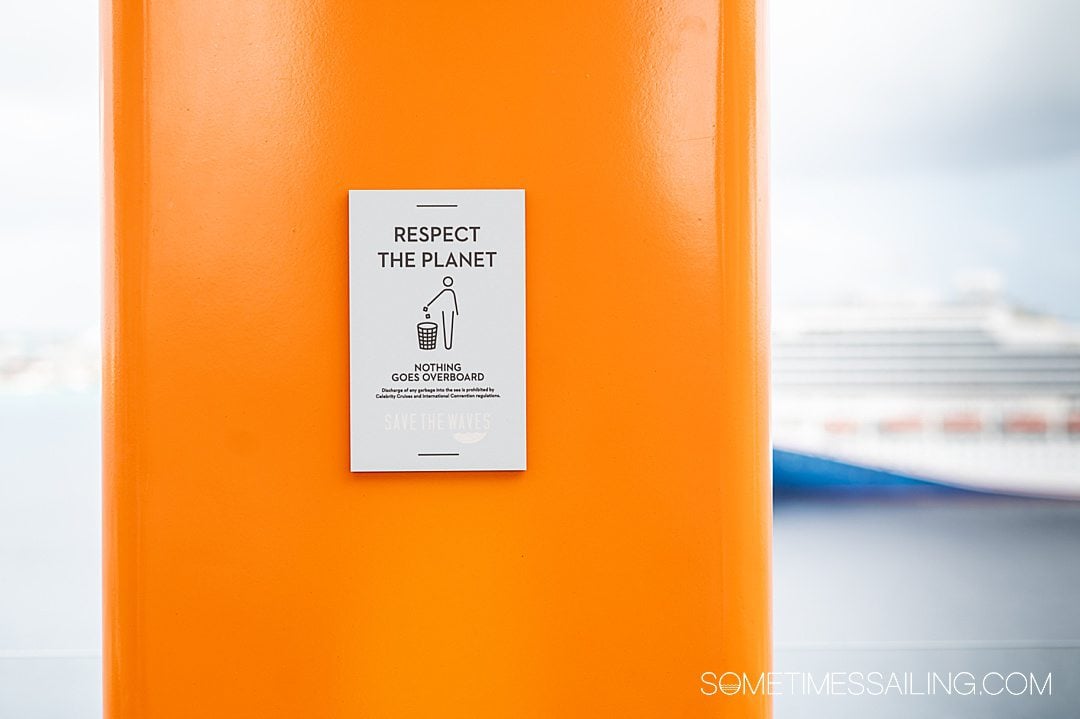
Norwegian Cruise Line: PortMiami Design
Norwegian Cruise Line's terminal at PortMiami , which opened in 2021, was the first to achieve Leadership in Energy and Environmental Design (LEED) Gold New Construction v4.0 certification.
NCL has a Sail & Sustain program that outlines its ESG goals. Five principles include:
- Reducing environmental impact (including increasing their sustainable sourcing, minimizing landfill waste, and combating climate change with new technologies and innovations)
- Sailing safely
- Empowering people
- Strengthening our communities
- Operating with integrity and accountability
All Norwegian Cruise Line sailings also have an Environmental Officer on board who is available to answer guest questions and ensure the ship (and its procedures) remain in environmental compliance. Each NCL crew member goes through Environmental Familiarization Training as well.
Royal Caribbean: Pledge to Save the Waves
Royal Caribbean's conservation efforts are admirable. What started in 1992 as a Save the Waves program has evolved into a company-wide philosophy. They implement “reduce, reuse, and recycle” in creative ways, like a donation program so their sheets, mattresses, towels, furniture, and clothing are reused instead of discarded during upgrades and remodels.
Aside from a sustainable seafood program that is mindful of our consumption from the sea, they installed Hydrothermal Oxidation Technology on Celebrity Apex to ensure food waste isn't discharged into the ocean.
In addition to this, they lead the way in a variety of onboard efficiencies and programs that guide cruise sustainability. It's typical for them to focus on 30 years into the future, not just tomorrow, next year, or five years from now.
Their ships can hold thousands of passengers and crew (Wonder of the Seas can accommodate close to 7,000 guests), which is why it's impressive that 100% of their ships are equipped to be landfill-free. In just two years, they reduced their single-use plastics on board by 60%. The glass used in their ship's design is energy-efficient and LED lights to help reduce energy consumption.
Over 2,000 tours offered across the Royal Caribbean fleet are in line with the Global Sustainable Tourism Council guidelines for certified sustainable excursions. They also chart the most efficient course to reach each port as they optimize cruising speeds to reduce the fuel needed to get there.
If you love the environment like us and love to geek out on as much information as possible pertaining to cruise sustainability, check out more information about Royal Caribbean Group's “Seastainability” programs .
Interested in cruising? Read this next:
- Importance of Eating Sustainable Seafood and Local Fish for Healthy Seas
- 21 Ways to Be a More Eco-Conscious Cruiser Before, During + After a Cruise
- Stasher Bags Review: 16 Ways to Use these Reusable Bags on a Cruise

Similar Posts
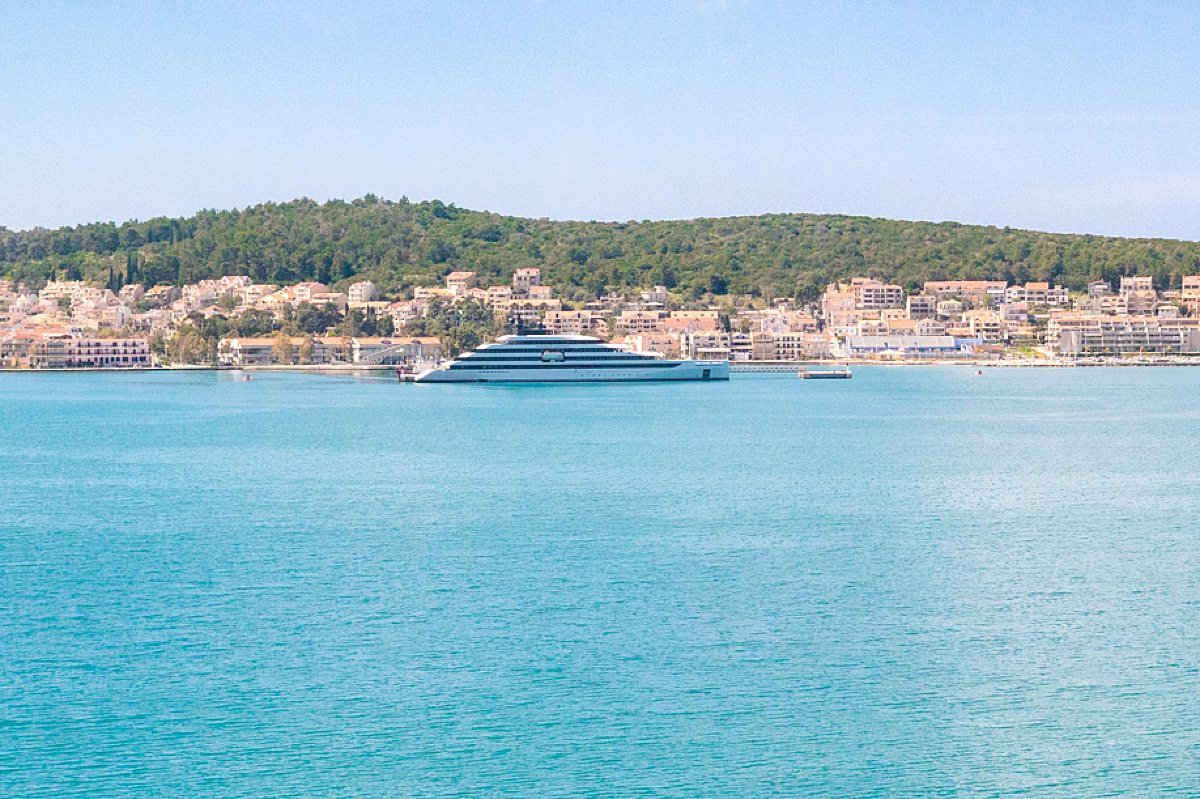
Emerald Azzurra Cruise Review: Onboard Yacht Experience
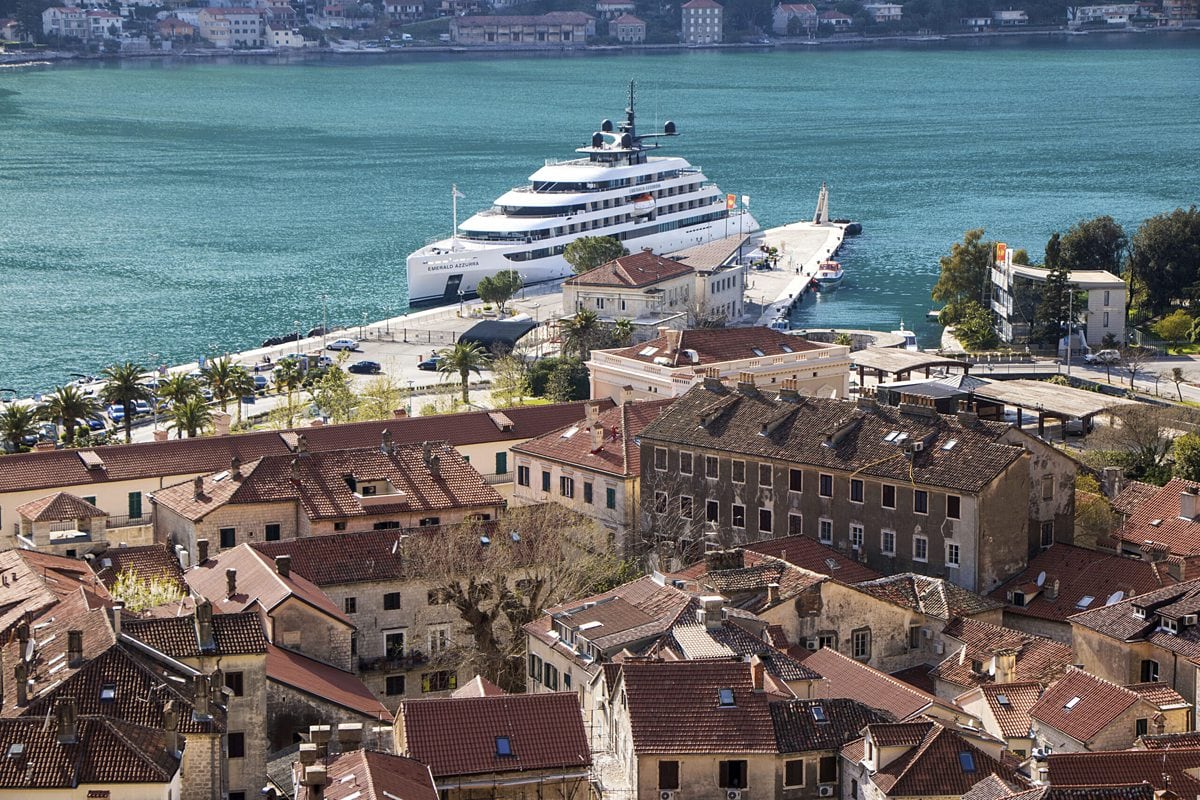
Emerald Azzurra vs. Scenic Eclipse: Super Yacht Cruises
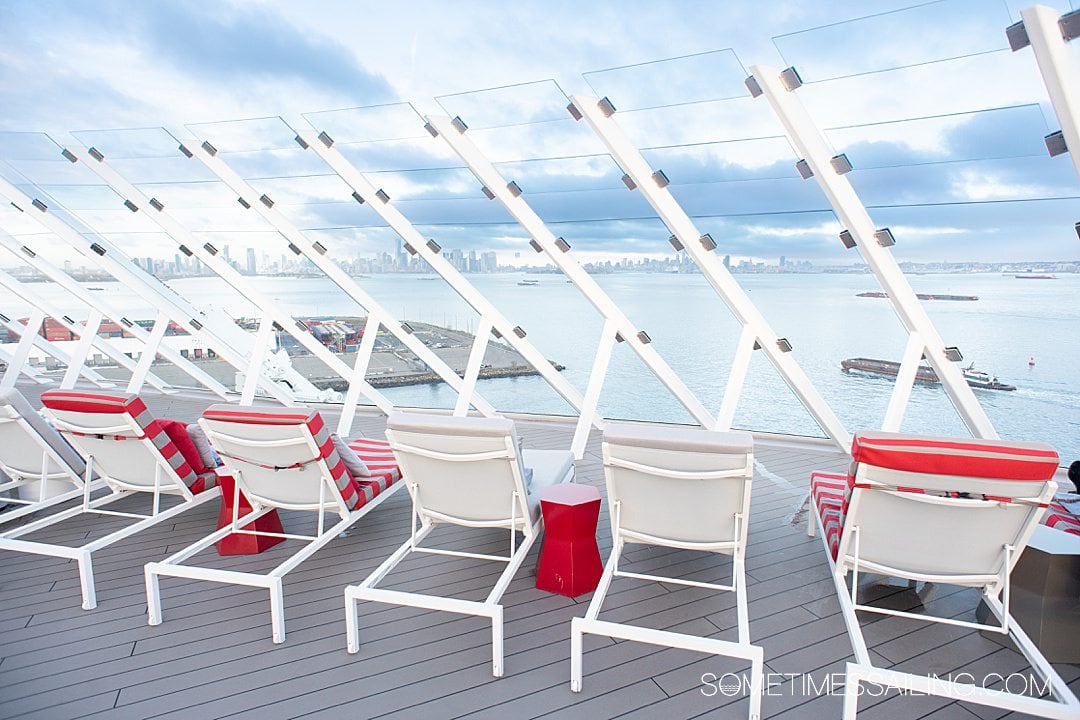
Gay Cruises: Here Is Your Ultimate Guide for 2024
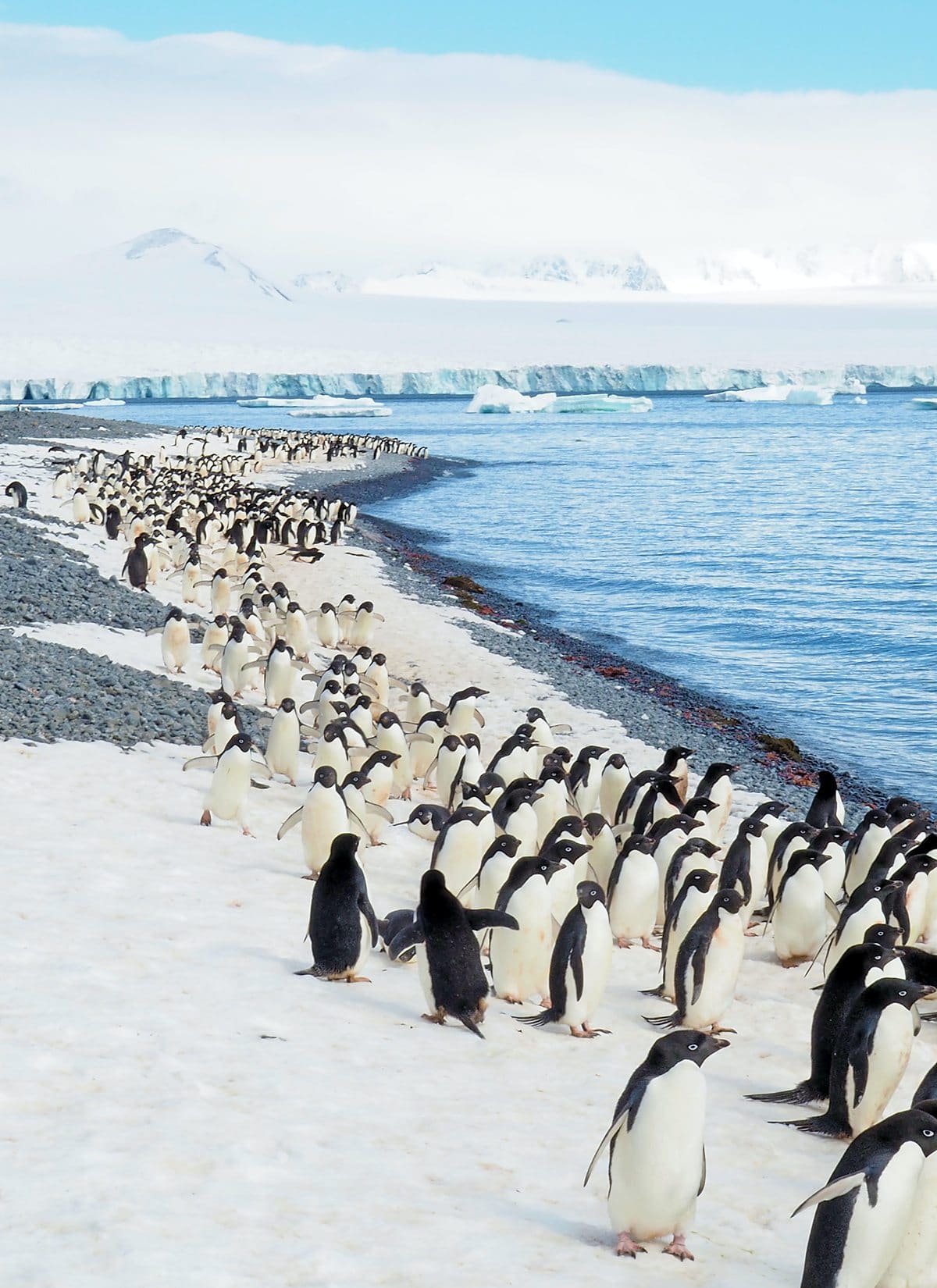
Clothing for Antarctica Cruise with a Printable Antarctic Packing List
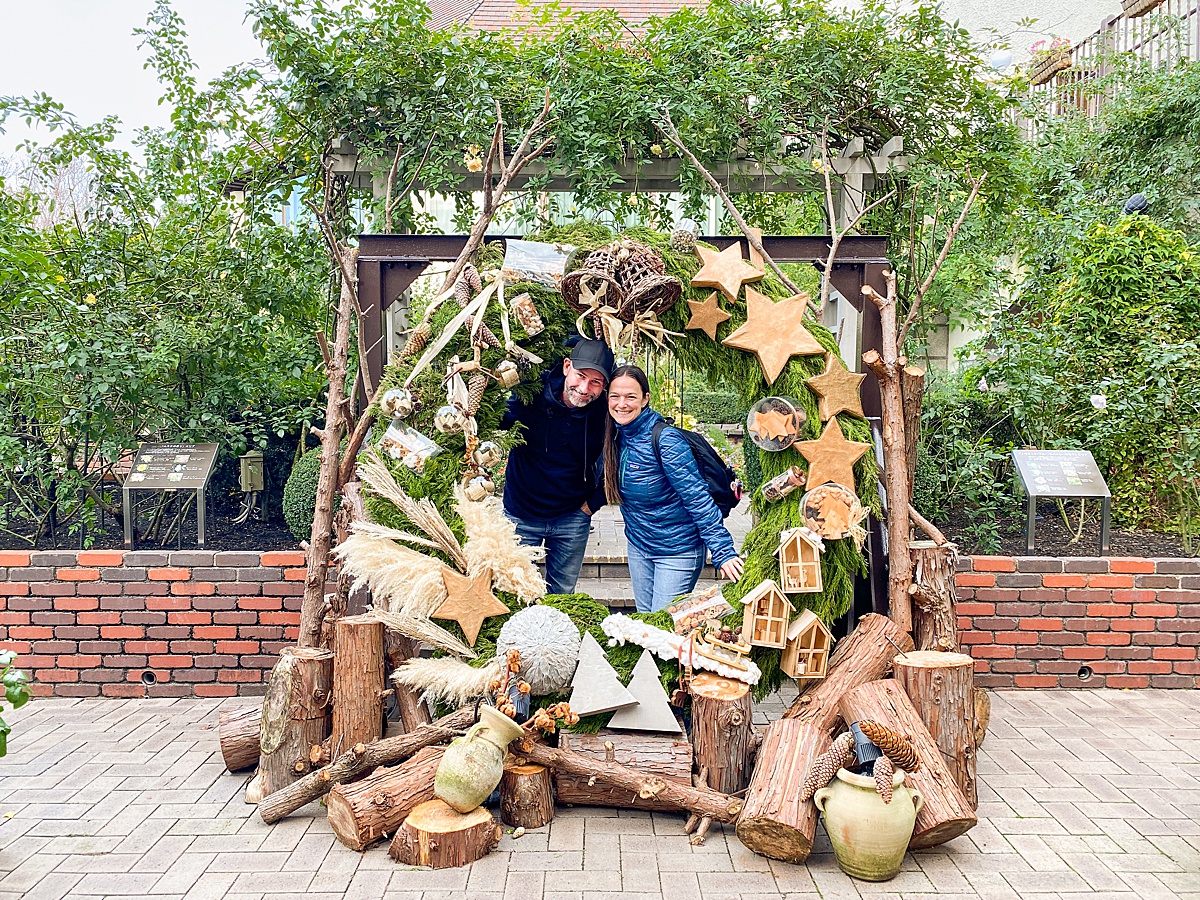
Christmas Markets River Cruises: All You Need to Know
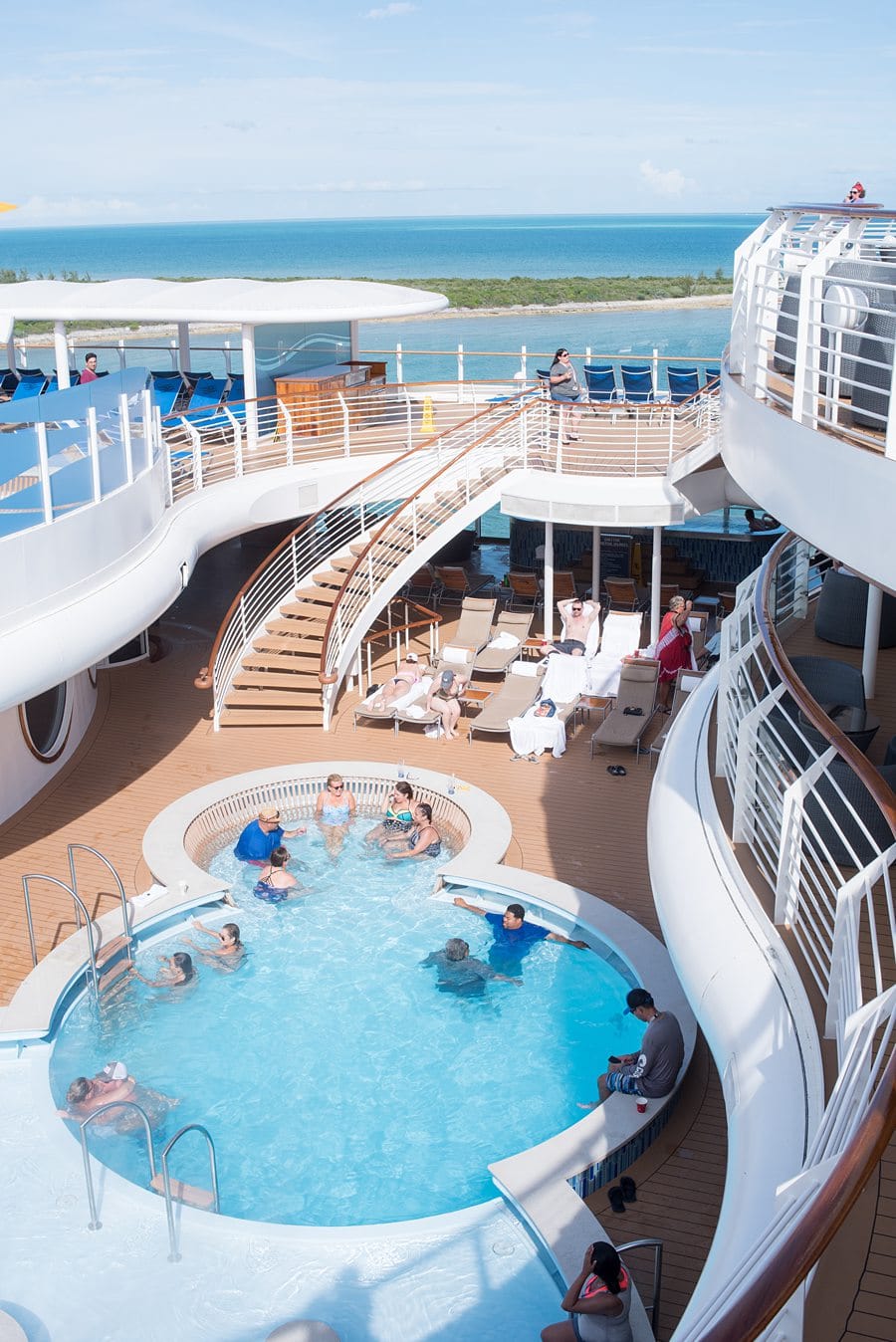
Disney Cruise For Adults: What to Experience on DCL Without Kids
Leave a reply cancel reply.
Your email address will not be published. Required fields are marked *
Save my name, email, and website in this browser for the next time I comment.
- Expeditions
Viking Health & Safety Program
- Health & Safety Program Health & Safety Program
- PRE-DEPARTURE PCR TEST PRE-DEPARTURE PCR TEST
- Expert Health Partners
- Health & Safety FAQ Health & Safety FAQ
- Health & Safety Program
- PRE-DEPARTURE PCR TEST
- Health & Safety FAQ
As the leading small ship cruise line, Viking takes you closer to the heart of the places you want to visit. For more than 23 years, we have always had the highest standards for health and cleanliness, and our new protocol enhancements make Viking even safer. Developed in coordination with an international team of scientific and medical advisors, the Viking Health & Safety Program is one of the most well-researched and comprehensive COVID-19 prevention and mitigation plans in the travel industry.
- Frequent quick and easy non-invasive saliva PCR tests for all guests and crew, processed in full-scale Viking-dedicated laboratories
- New air purification technology installed on all Viking ships, which have always featured independent air handling units for all guest staterooms
- Additional health checks, sanitization and physical distancing to protect Viking guests and crew at all points of the journey
Message from our Chairman
On December 8, 2020, Viking Chairman Torstein Hagen introduced the new Viking Health & Safety Program and discussed the research that has informed the basis for our protocol enhancements.
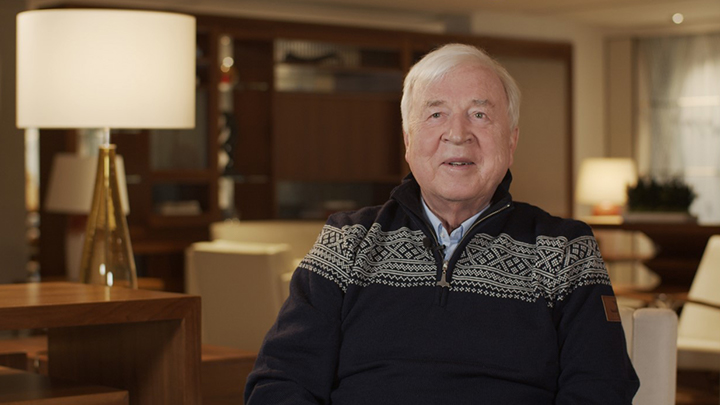
Viking Health & Safety Program – Updated October 15, 2021
The information included here should be considered current for all guests. Specific protocols and procedures may evolve over time to adapt to various conditions or travel regulations in the destinations in which we operate. Please continue to check this site for the most up-to-date version of the Viking Health & Safety Program.
Health & Safety FAQ
Does viking require guests to be vaccinated.
Beginning on May 22, 2021 with the official restart of limited operations in the United Kingdom—and remaining in effect at least through at least September 30, 2021—all Viking sailings will be available exclusively for vaccinated guests.
Viking is requiring vaccinations among all guests in accordance with entry rules in many of the destinations that will welcome Viking ships—and as a complement to our new health and safety protocol enhancements, which were designed to protect guests and crew even while the COVID-19 vaccine rollout is still moving forward. Viking’s medical and operations teams will continue to monitor vaccination rates and entry requirements—and will adjust our protocol and policies as needed to ensure the safety and wellbeing of our guests and crew.
How long will the vaccine requirement for guests remain in effect?
Currently, we will require vaccinations among guests for sailings scheduled to depart at least through September 30, 2021. Viking’s medical and operations teams will continue to monitor vaccination rates and entry requirements—and will adjust our protocol and policies as needed to ensure the safety and wellbeing of our guests and crew.
Will I be required to take a COVID-19 test before traveling to a Viking Ship?
Viking does not require our guests to take a COVID-19 test before departing from home. Depending on your dates of travel, Viking may require a PCR test as part of the process of embarking your ship. This quick and easy non-invasive PCR test will be conducted via simple saliva sample in a plastic tube and processed in a full-scale Viking-dedicated laboratory.
However, entry requirements can and do vary by country, so guests should be sure to visit the Viking website and read the Pre-Cruise Requirements found under the Resources tab of their itinerary, in addition to following all guidelines that may be provided by email and/or on MyVikingJourney.com .
arrrrrrrrrrrrrrrrgh
You say guests will be tested frequently during the cruise. What type of COVID-19 test will be conducted and how is the test performed?
Viking will use PCR testing, as this is considered the best type of test to detect the virus. The quick and easy non-invasive PCR test will be conducted by simple saliva sample in a small plastic tube, delivered to guests in their stateroom. After guests provide the saliva sample in the tube, they will package the tube in a provided plastic pouch, and a crew member will collect the sample for processing.
How frequently will guests be tested?
Quick and easy PCR tests will be conducted prior to embarkation and on an ongoing, regular basis throughout an itinerary, dependent on prevalence levels from both our guests’ country of origin and the destinations to which we will sail.
Are crew tested as frequently as guests?
All Viking crew will be tested at the same or higher frequency as our guests.
What happens if a guest tests positive for COVID-19 at embarkation?
Guests with a positive COVID-19 test at embarkation will be given a second test to validate the first. If the second test confirms COVID-19, Viking will arrange for the guest to recover ashore before returning home once their recovery is complete. Upon their return home, Viking Customer Relations will contact the guest and their travel advisor directly regarding any necessary refunding or rescheduling.
What happens if a guest tests positive for COVID-19 while on their Viking cruise?
Guests with a positive COVID-19 test will be isolated on board and then disembarked at the first opportunity for quarantine at an appropriate facility ashore. A second test will be performed to validate the first test. If the second test confirms COVID-19, we will arrange for the guest to recover ashore before returning home once their recovery is complete. Upon their return home, Viking Customer Relations will contact the guest and their travel advisor directly regarding any necessary refunding or rescheduling.
What happens if there are a large number of COVID-19 cases on board my ship?
Viking’s Health & Safety Program is focused on the prevention and mitigation of COVID-19. Our research shows that because Viking will test all guests and crew daily, the risk of a large number of guests or crew falling ill is very low. However, we plan for all scenarios – and we have contingency plans in place should this unlikely scenario arise.
COVID-19 is known to spread through the air. How is the air treated onboard Viking ships?
Our fleet of modern, small ocean and river ships feature independent air handling units, which means each stateroom has “fresh” external air that is not shared with other staterooms or public spaces. Just like in a hospital, we have also designed a solution to implement short-wavelength ultraviolet (or UV-C) lights and new high-density filters that will sanitize the air on our vessels. This solution will ensure that:
- 99.99% of viruses and bacteria in the air are killed.
- We maximize the possible number of air changes.
- We provide a risk-free solution for the crew when cleaning filters, as viruses are killed and not simply trapped in the filters.
How frequently do you sanitize my stateroom?
Every stateroom is cleaned and sanitized daily. In addition, every stateroom goes through a “deep-cleaning” sanitization process between each cruise.
How frequently do you sanitize public spaces such as the restaurants?
Restaurants are sanitized between every service; all other public spaces are fully sanitized at a minimum every 24 hours, with high touchpoints sanitized more frequently every day.
Will I be required to wear a face mask while on board?
Face masks may be required for all guests and crew while moving about the ship, depending on conditions at time of sailing.
Will I be required to wear a face mask when going ashore?
Viking may require guests and staff to wear a face mask while ashore, depending on local requirements.
Will there be social distancing on board?
We have set up all of our public spaces, including restaurants and lounges, for appropriate social distancing.
Is there a difference between what I can expect on a Viking ocean ship and a Viking river ship?
Our Viking Health & Safety Program is the same across our fleet of ocean and river vessels. Viking ocean and river ships, however, differ in size and number of venues. As such, guests traveling on either an ocean or river ship may experience minor day-to-day variations in how we implement our overall program.
Does Viking’s Travel Protection Plan cover COVID-19 costs (e.g., medical treatment, quarantine, repatriation, etc.)?
Yes, our Travel Protection Plan helps protect you from many unforeseen circumstances that may arise before or during your trip, which could include necessary medical, quarantine or repatriation expenses related to COVID-19.
Sign up to receive updates from Viking
Stay current with special offers, news and destination-focused content.
Company Information
- Order a Brochure
- Travel Advisors
- Media Center
- Investor Relations
- Health & Safety Program
- Privacy Policy
- Cookie Policy
- Manage Cookies

Viking River Cruises
- Mississippi
Viking Ocean Cruises
- Scandinavia
- British Isles & Ireland
- North America
- Caribbean & Central America
- South America
- Mediterranean
- Quiet Season Mediterranean
- Australia & New Zealand
- World Cruises
- Grand Journeys
Viking Expeditions
- Great Lakes
- Longitudinal World Cruises
Viking Cruises founder Torstein Hagen: How tailoring experiences for Chinese tourists drives growth
A little over two decades ago, Torstein Hagen founded Viking Cruises as a four-vessel river cruise operation carrying passengers from Moscow to St. Petersburg. Hagen’s company has since grown to become the world’s largest river cruise line, sailing as far afield as the Nile and the Yangtze, and operating more than 70 vessels, including six ocean ships.
In the early 2000s, the Norwegian spotted a gap in the US market for premium European cruises. He deduced that American customers poorly served by bus tour operators would appreciate a more comfortable way to visit the old continent; a single place of lodging rather than half a dozen hotels; and an experience that reminded them of home, at least until they stepped ashore.
Viking now accounts for half the American passenger cruise market in Europe. Its vessels eschew casinos, race tracks, and high-energy activities in favor of minimalist décor, live classical music, and destinations featuring cultural excursions, guest lectures, and cooking lessons.
Seeking to tap the world’s largest outbound tourism market, Viking opened its first China office in 2016, promoting a single cruise, before expanding services that led to triple-digit annual passenger growth. Customers appreciated the model of understated elegance to the extent that they returned an industry-leading net promoter score of 78, and at the start of 2020, Viking was on track to serve 30,000 Chinese passengers across six European river cruise liners designed and staffed specifically for Mandarin speakers. As the year closed, it announced joint-venture plans for the world’s first ocean cruise line dedicated to the China market.
However, the outbreak of COVID-19 has cast a pall over the industry. Bookings are down amid reports of cruise ships being turned away from ports. The Asia market, which hosts capacity for more than 4 million cruise passengers annually across almost 40 brands, is suffering particularly acutely. Viking has temporarily canceled sailings in all markets it operates in.
Against this difficult backdrop, Hagen sat down in his capacity as Viking’s chief executive officer to discuss company strategy with Steve Saxon, a McKinsey partner in Shanghai, and Jackey Yu, an associate partner in Hong Kong. He suggests Viking will press on with marketing in China throughout the virus outbreak, while explaining how Viking tailors its European cruise program for Chinese customers, and why price and product integrity stand out in the China market.
McKinsey: How has your outbound Chinese tourist business evolved since you launched European river cruises?
Torstein Hagen: We launched in 2016 with one cruise and 16 passengers, and last year served 20,000 Chinese passengers in Europe. The best case amid the virus outbreak is we’ll host 15,000 passengers in 2020, and rebound next year to nearly 40,000. Our goal is 150,000 by 2025. Chinese passengers average about 10 nights per trip—three or four nights longer than regular cruisegoers. Average sale per customer is about 3,000 RMB per night. We’ve also increased our yield materially, and were on pace to have a retention rate across three or four years of over 30 percent, compared with an industry average in China of under 5 percent.
McKinsey: What was the rationale behind launching your China-focused proposition in Europe?
Torstein Hagen: China is the world’s largest travel market, so we ought to be there. We came in believing there was a product opportunity; that pricing would come over time as Chinese were willing to spend more on experiences. People, whether Chinese or American, are not so different. This wasn’t about reinventing Viking for China, it was about taking what we already did and making it Chinese: the language, the food, and the experience.
This year, we aim to operate six ships for the Chinese market on the Rhine and the Danube, each hosting 175 to 190 guests. They function as Mandarin-only hotels, with all the signage and excursions in Chinese, and the food cooked by Chinese chefs. We made a unique commitment that customer-facing crew from the hotel side had to speak Chinese, and recruited them from the best hotels in China.
McKinsey: Why did you commit to making the vessels Mandarin-only?
Torstein Hagen: Two decades ago, we bought Germany-based KD River Cruises. They marketed across Europe and the world, so there were a host of nationalities on board. Our experience showed multiple languages are an unattractive proposition for the consumer; it’s a better product with only one group. It’s also operationally troublesome having menus and excursions in multiple languages. We doubled-down on the English-speaking market, largely Americans, and have applied the same philosophy to China. There was also a gap in the market because Chinese consumers searching for better products are not properly served by their domestic travel companies, and the international travel landscape largely fails to cater to their tastes.
McKinsey: Do you feel the proposition scales up to 1,000-passenger ocean ships?
Torstein Hagen: We decided to scale-up gradually on river ships and then add ocean liners when we have the scale. Chinese people don’t necessarily recognize river cruise destinations like Rüdesheim, or Heidelberg, so that proved a challenge. When we launch ocean trips in a couple of years, we’ll run our “In Search of the Northern Lights” cruise in northern Norway, which Chinese people will recognize and enjoy.
McKinsey: Strategically, how do you view the rise of Chinese outbound tourism?
Torstein Hagen: The strategy is similar to when we launched our US business: we compete against bus tour operators. A river cruise is a better product; more relaxing, and easier to manage. In catering to Chinese customers, we can leverage our existing prime docking stations in key European cities, and other fundamental advantages we hold from operating in the region since 1997. Most bus tours and the majority of our competitors have about one Chinese speaker for every 40 guests. Viking has one Chinese speaker for every 3.5 guests, and we carry our own guides, matching around one guide per 16 to 20 people, augmented by a local guide office. We offer an unrivalled level of service and attention.
McKinsey: Do Chinese tourists have any specific traits that make them standout as customers?
Torstein Hagen: The biggest difference is WeChat, which is an incredibly powerful tool but difficult to work with for marketers, and the complexity and uniqueness of China’s social media environment. From a customer perspective, the US and China markets are almost identical, with one big difference: the appetite for foreign travel is much greater in China, and there’s a larger gap between a lot of products and expectations.
McKinsey: How do you engage with Chinese customers across ecosystems that use very different social media and marketing tools?
Torstein Hagen: There is a greater trust differential compared with the US: people have to believe you’re a real brand, especially if you’re asking for 50–60,000 RMB per cabin. Our marketing strategy is clear: fill social media with content, make sure people know who we are, and allow as many people as possible to give honest feedback. Real success, as in the US, will depend on brand advocacy from travelers. If you have a net promoter score in the high 70s, it means people are spreading the word. In combination with the very social environment in China, that’s a powerful tool.
Torstein Hagen biography
Born in 1943
Holds a degree in physics from the Norwegian Institute of Technology, where he completed his Master’s Thesis related to artificial intelligence and machine learning.
Earned a Master of Business Administration from Harvard University.
Studied computers at Wesleyan University on a Fulbright Scholarship.
Leads the world’s most successful river cruise line as Chairman, and manages operations across an ocean fleet of six ships.
Secured a joint venture partnership with China Merchants Shekou & Group ahead of launching a dedicated Chinese ocean cruise line.
Launched European river cruises for Chinese customers in 2016, expanding the business to 20,000 customers a year in 2019.
Purchased KD River Lines in 2000 to expand Viking’s European river cruise portfolio, ahead of entering the American market.
Founded Viking Cruises in 1997 with the purchase of four river vessels in Russia.
Helmed Royal Viking Line as CEO from 1980 to 1984, before losing control to Norwegian Caribbean Lines.
Served as a member of the board of directors for Holland America Line and Kloster Cruise Ltd.
Led Bergen Steamship Co. as CEO from 1976.
Advised cruise companies on their strategy as a partner in McKinsey & Company’s European offices.
McKinsey: Travel brands find direct marketing a challenge in China, but you’ve had strong success. What’s the secret?
Torstein Hagen: We have a good partner who allows us to develop a one-on-one customer relationship, and use our brand as the messaging tool versus forcing their brand forward. Our success is also driven by declining trust in travel agents in China. As much as we police it, agencies still rebate commissions and try to manage their products independently. If you look at our competitors on Online Travel Agency platforms, they normally sell 12 nights, 10 days. How can you have a 12-night, 10-day travel experience? You sleep on the plane. When we tell you 10 days, it’s 10 days in Europe and nine nights. Price transparency, product transparency, and integrity is how you build long-term brand value. Our travel partners support that philosophy.
McKinsey: Did you enter China seeking to emulate the direct model that has proved successful in the US and UK, or was it a separate decision process?
Torstein Hagen: We are not direct sellers, we are direct marketers. Nobody should get between us and the guest when it comes to what we sell, in terms of the package and the price. We need to have a direct conversation with consumers; and own our product, delivery, pricing, and yield. We are not concerned whether customers buy with travel agents, which have always been an important component of our businesses, but we do care that they buy a Viking product. There was considerable pushback from agents, with multiple canceled bookings when we refused requests for extra commission or special requirements. We do not allow agents or other intermediaries to repackage under their brand.
McKinsey: What is your advice to foreign companies on choosing and working with a local Chinese partner?
Torstein Hagen: Understand what your needs are, be very clear about what you expect, and make sure it’s a mutual win. Don’t worry about short-term cost versus long-term benefit. If you’re worried about the short term, you’re going to find it very difficult in China.
McKinsey: How does Viking drive the China agenda, while balancing control from headquarters with flexibility from the local team?
Torstein Hagen: China is our top strategic initiative for the next decade. We run strategy accordingly with close oversight from the center in terms of choosing partners and capital allocation. At the same time, we clearly instill our brand values in the China team, and have people there who understand our brand. We allow them to localize operations and control how messaging and creative works in China, as long as it’s brand appropriate. If something goes out that is not brand appropriate, then we have a clear and open dialogue about how to learn from that mistake.
McKinsey: How do you balance the freedom to design messaging in China with the sales organization and brand team being in the US?
Torstein Hagen: The US will always be, certainly until China becomes bigger, the foundational decision maker of what our brand represents. Then we allow flexibility for China to interpret that. For example, in the US, we’ve taken a position that our customer is aged 18 and over. In China, everybody wants to travel in July and August with their grandchildren. We adapted and said it was eight and over in China, and designed art programs to culturally enrich and entertain the kids.
McKinsey: What do you see as the biggest challenge to continuing the growth momentum of Chinese outbound tourism?
Torstein Hagen: The biggest global challenge is that Chinese travelers are generally treated poorly, and that lack of respect may eventually lead them to vote with their wallets. There is also a risk that the more presence we have as a brand, the more motivated travel agencies, tour operators, and others are going to be to have their own ships and capacity, and we end up in a price-based fight for market share. But consumers are smart, so they’ll distinguish between the real thing and a copycat. In the US, we started off with 25 percent market share 10 years ago but by spending money on messaging through tough times we now have 50 percent. I can’t see why we shouldn’t have 50 percent share of Chinese travelers in Europe.
McKinsey: Assuming the coronavirus virus outbreak subsides, what are your plans for the future in China?
Torstein Hagen: We have announced our partnership with China Merchants Group, which should form a basis to create a large domestic Chinese cruise line. That’s our focus.
McKinsey: How do you think the virus outbreak crisis will evolve, and what will be the impact on the cruise market?
Torstein Hagen: It’s hard to tell. Fortunately, we have taken precautions. Our ships are small, so the likelihood of getting infected with us is much smaller. But that’s probably not a big consolation; it’s going to be difficult for the whole market.
McKinsey: Do you think the issues with other cruise ships, which have hosted significant coronavirus outbreaks, have damaged the image of cruising as a whole, and if so, will it bounce back?
Torstein Hagen: Yes, and yes. They, and the cruise industry, received a lot of advertising they did not need, and the crisis management challenge was very difficult, but history says it will be cyclical. The affected cruise lines were in a very difficult position managing sick people in a closed environment, and it was the authorities’ decision to impose and implement quarantine. It will have a real impact on the China cruise industry for the next year.
McKinsey: How did you look after Chinese customers with existing bookings through the COVID-19 crisis?
Torstein Hagen: We hadn’t started the season yet, so we didn’t have Chinese who were already abroad. The first thing we did is send a message reassuring our customers that we would look after them. We canceled the first-half schedule, and returned all payments. We also offered a program for customers to leave money on account and receive a loyalty bonus. No matter what happens with COVID-19, we need at least six to eight weeks of quiet before we bring Chinese back to Europe. Rushing them back will lead to misery for travel brands. Fortunately, we are in a very strong financial position, so we can focus solely on our customers.
Steve Saxon is a partner in McKinsey’s Shenzhen office. Jackey Yu is an associate partner in the Hong Kong office.
Explore a career with us
Related articles.
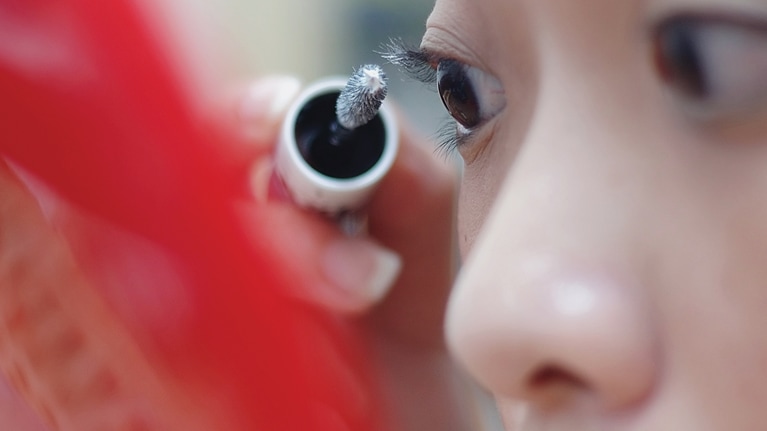
The Chinese luxury consumer

How China’s largest online travel agency connects the world: An interview with Ctrip CEO Jane Sun

Huānyíng to the new Chinese traveler

Find Your Cruise
Cruise Type Expedition Cruise Ocean Cruise River Cruise
Destination Africa Alaska America Antarctica Arctic Circle Asia & Far East Atlantic Islands Australasia Baltic British Isles Canada Canary Islands Caribbean Central America Europe Greek Isles Hawaii Iberia Indian Ocean Mediterranean Middle East Nile Cruise Norwegian Fjords Pacific Panama Canal River Scandinavia South America South Pacific West US/Mexico
When May 2024 June 2024 July 2024 August 2024 September 2024 October 2024 November 2024 December 2024 January 2025 February 2025 March 2025 April 2025 May 2025 June 2025 July 2025 August 2025 September 2025 October 2025 November 2025 December 2025 January 2026 February 2026 March 2026 April 2026 May 2026 June 2026 July 2026 August 2026 September 2026 October 2026 November 2026 December 2026 January 2027 February 2027 March 2027 April 2027 May 2027 June 2027 July 2027 August 2027 September 2027 October 2027 November 2027 December 2027 January 2028 February 2028 March 2028 April 2028 May 2028 June 2028 July 2028 August 2028 September 2028 October 2028 November 2028 December 2028 January 2029 February 2029 March 2029 April 2029
Cruise Line Abercrombie & Kent Expedition Cruises AmaWaterways Atlas Ocean Voyages Azamara Cruises Celebrity Cruises Celestyal Cruises Crystal Cruises Cunard Elixir Cruises Emerald Waterways Emerald Yacht Cruises Explora Journeys Fred Olsen Cruise Lines Hapag-Lloyd Cruises Holland America Line Hurtigruten Cruises Hurtigruten Expeditions Oceania Cruises P&O Cruises Paul Gauguin Cruises Ponant Cruises Princess Cruises Regent Seven Seas Cruises Riverside Luxury River Cruises Saga Cruises Scenic Ocean Cruises Scenic River Cruises Seabourn Cruises SeaDream Yacht Club Silversea Cruises Star Clippers Cruises Swan Hellenic Cruises Uniworld River Cruises Viking Cruises Windstar Cruises
Ship A&K L'Austral A&K Le Commandant Charcot Allura AmaBella AmaCello AmaCerto AmaDahlia AmaDara AmaDolce AmaDouro AmaKristina AmaLea AmaLilia AmaLucia AmaLyra AmaMagdalena AmaMagna AmaMelodia AmaMora AmaPrima AmaReina AmaSerena AmaSiena AmaSintra AmaSonata AmaStella AmaVerde AmaVida AmaViola Arcadia Aria Amazon Arvia Aurora Azamara Journey Azamara Onward Azamara Pursuit Azamara Quest Azura Balmoral Bolette Borealis Britannia Caribbean Princess Celebrity Apex Celebrity Ascent Celebrity Beyond Celebrity Constellation Celebrity Eclipse Celebrity Edge Celebrity Equinox Celebrity Flora Celebrity Infinity Celebrity Millennium Celebrity Reflection Celebrity Silhouette Celebrity Solstice Celebrity Summit Celebrity Xcel Celebrity Xpedition Celebrity Xploration Celestyal Discovery Celestyal Journey Coral Princess Crown Princess Crystal Serenity Crystal Symphony Diamond Princess Discovery Princess Emerald Azzurra Emerald Dawn Emerald Destiny Emerald Harmony Emerald Kaia Emerald Liberte Emerald Luna Emerald Princess Emerald Radiance Emerald Sakara Emerald Sky Emerald Star Emerald Sun Enchanted Princess Eurodam Europa Europa 2 Explora I Explora II Ganges Voyager II Grand Princess HANSEATIC inspiration Insignia Iona Koningsdam Le Bellot Le Boreal Le Bougainville Le Champlain Le Commandant Charcot Le Dumont D'urville Le Jacques Cartier Le Laperouse Le Lyrial Le Paul Gauguin Le Ponant Le Soleal M/S Paul Gauguin Majestic Princess Marina Mekong Jewel MS Fram MS Fridtjof Nansen MS Kong Harald MS Maud MS Nordkapp MS Nordlys MS Nordnorge MS Polarlys MS Richard With MS Roald Amundsen MS Santa Cruz II MS Spitsbergen MS Trollfjord MS Vesteralen Nautica Nieuw Amsterdam Nieuw Statendam Noordam Oosterdam Queen Anne Queen Elizabeth Queen Mary 2 Queen Victoria Regal Princess Regatta River Duchess River Empress River Princess River Queen River Tosca Riverside Mozart Riviera Royal Clipper Royal Princess Ruby Princess Ryndam S.S Beatrice S.S. Antoinette S.S. Bon Voyage S.S. Catherine S.S. Elisabeth S.S. Joie de Vivre S.S. La Venezia S.S. Maria Theresa S.S. Sao Gabriel S.S. Sphinx S.S. Victoria Sapphire Princess Scenic Amber Scenic Azure Scenic Crystal Scenic Diamond Scenic Eclipse Scenic Eclipse II Scenic Gem Scenic Jade Scenic Jasper Scenic Jewel Scenic Opal Scenic Pearl Scenic Ruby Scenic Sapphire Scenic Spirit Seabourn Encore Seabourn Odyssey Seabourn Ovation Seabourn Pursuit Seabourn Quest Seabourn Sojourn Seabourn Venture SeaDream I SeaDream II Seven Seas Explorer Seven Seas Grandeur Seven Seas Mariner Seven Seas Navigator Seven Seas Splendor Seven Seas Voyager SH Diana SH Vega Silver Cloud Silver Dawn Silver Endeavour Silver Moon Silver Muse Silver Nova Silver Origin Silver Ray Silver Shadow Silver Spirit Silver Whisper Silver Wind Sirena Sky Princess Spirit of Adventure Spirit of Discovery Star Breeze Star Clipper Star Flyer Star Legend Star Pride Star Princess The Elysium Ventura Viking Hathor Viking Helgrim Viking Hemming Viking Jupiter Viking Mars Viking Octantis Viking Osfrid Viking Saturn Viking Sea Viking Sky Viking Star Viking Tir Viking Torgil Viking Vela Viking Venus Viking Vesta Vista Volendam Westerdam Wind Spirit Wind Star Wind Surf World Navigator World Traveller World Voyager Zaandam Zambezi Queen Zuiderdam
Duration 10 to 14 nights 15 nights or more 4 nights or less 4 to 7 nights 7 to 10 nights
Home Blog Cruise Sustainability
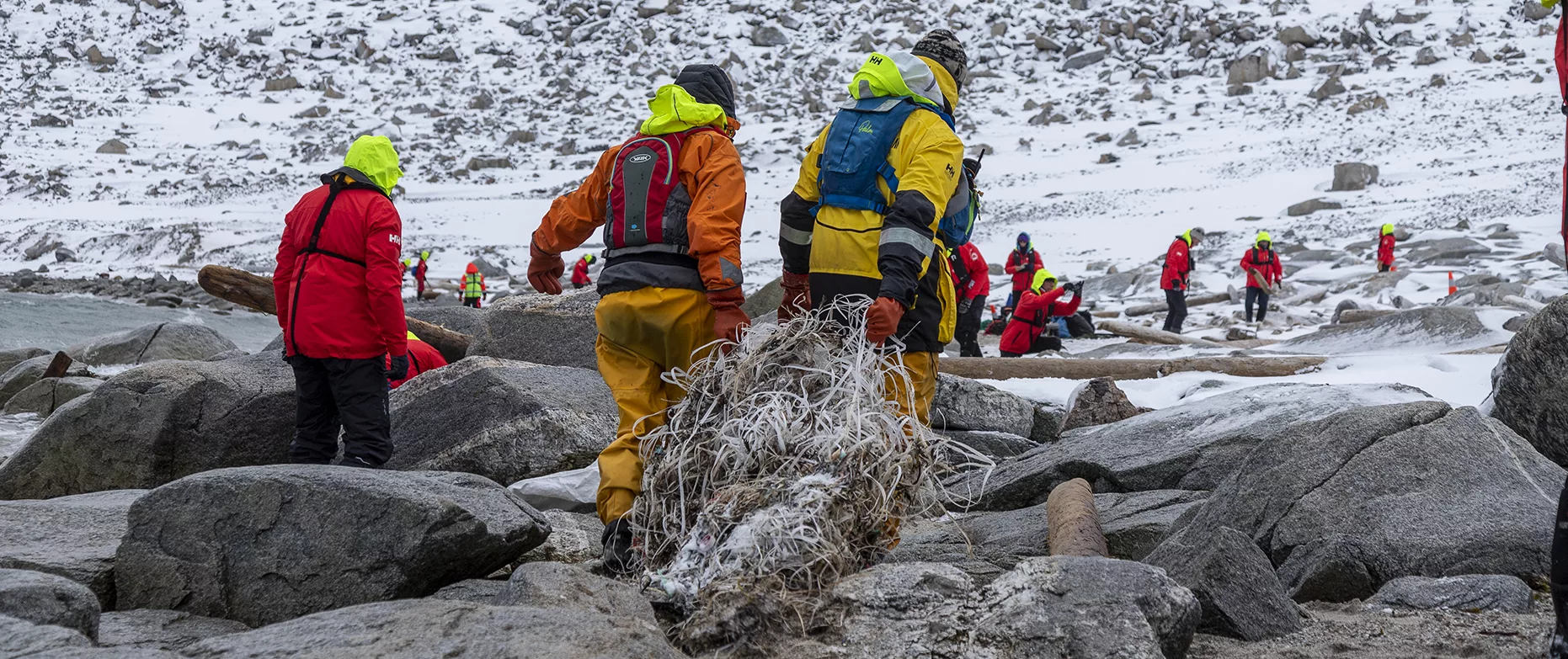
Cruise Sustainability
Today is Earth Day, a day dedicated to raising awareness and bringing people together to take action in the fight against climate change. For over 50 years, citizens, businesses and governments have come together with a shared passion for sustainability. From The Great Global Cleanup to The Canopy Project, millions of us have volunteered and donated, and in doing so, we have contributed to a greener future.
The theme for 2022 is ‘Invest In Our Planet. What will you do?’ At The Cruise Line, we understand that we all have a part to play. That’s why we’ve decided to plant a tree in Malawi for every cruise that gets booked with us. In doing so, we help the nation achieve its goal of restoring 4.5 million hectares of degraded land by 2030. But what are our partners doing to make a change?
It’s somewhat stating the obvious, but cruising has never had the best reputation for sustainability and environmental protection. Over the years, the criticisms have come thick and fast, promoting the idea that if you want to travel responsibly, doing so by cruise ship is not the answer.
A simple online search will reinforce this perspective, with data available on everything regarding passenger footprints tripling in size while cruising on a ‘large’ ship to the amount of waste and greywater generated during a one week voyage .
Despite its notoriety, it’s impossible to deny that the industry is making great strides to not only improve its image but, more importantly, to implement real tangible change. Most cruise operators have spent the past decade implementing vital strategies for enhanced sustainability, allied with a keen focus on reducing their fleets’ carbon footprint.
The Cruise Lines International Association is a critical player in this drive for change. As the world’s most prominent cruise industry trade organisation, CLIA has continued to advocate for sustainable cruising. CLIA’s message is clear: reduce carbon emissions by 40% by 2030. In addition, the association is also pursuing carbon-neutral cruising by 2050 across fleets of ocean cruise lines worldwide.
During 2018’s Seatrade Global Conference, CLIA’s president and CEO Cindy D’Aoust made an impassioned plea to those attending, requesting unity and innovation to improve sustainability.
“Because we are at sea, we must do better. We must be more efficient, we must be more effective, and we must be more mindful than the land-based resorts. No single community has a great imperative to protect the environment and ensure that the ports and destinations cruise ships visit thrive sustainably.”
As with any industry, some cruise lines have responded to the need for more earth-friendly cruising than others. However, early adopters are already on their way to becoming carbon neutral. At the same time, even those operators seen to be in the infancy of change have at least made small steps towards a more sustainable future.
What are the cruise lines doing to improve the environmental impact of cruising?
Here is a look at some of the steps taken by cruise lines to improve the impact cruising has on the environment.
Green fuels
The use of liquified natural gas (LNG) helps to eliminate sulphur emissions and reduce nitrogen oxides by 85%. In addition, LNG is the way forward for many new-build ships, while several operators are retrofitting older vessels for greener performance. Hurtigruten has taken this approach one step further, with six vessels running on a combination of LNG and battery power.
Onboard recycling & the reduction of single-use plastics
Nearly every cruise line has significantly reduced the amount of single-use plastics aboard their ships. Estimates suggest that ships now recycle up to 60% more waste since introducing more efficient ways to reduce, reuse, and recycle.
Advance water waste treatment
Water waste treatments are being installed across more fleets to treat water before being released into the marine environment. According to CLIA , some vessels repurpose 100% of water waste, while on average, “cruise ship waste management professionals recycle 60% more waste per person than the average person recycles on shore each day”.
Energy efficiency
Many cruise lines have focused on improving the efficiency of their fleets, using energy alternatives where possible:
- Installation of LED lighting, using 80% less energy
- The ability to connect to shore power when in port, reducing unnecessary emissions
- Tinted windows to recycle heat onboard
- The incorporation of solar panels to provide renewable energy
Optimised ship design
Several new-built vessels have an optimised hull to reduce drag and improve fuel efficiency where possible. One of the leading examples of such a design is Aurora Expedition’s Greg Mortimer, which boasts an X-Bow to reduce fuel consumption.
Cleaner exhausts
Cruise lines including NCL and Carnival have installed Exhaust Gas Cleaning Systems (EGCS), which “scrub” exhausts from high-sulphur fuel and thus improve the quality of air emissions. The system removes sulphur oxide and particle matter before leaving the ship, resulting in clean white steam plumes.
Partnerships & projects
Many cruise lines partner with charities and organisations to better promote sustainability and environmentally-friendly practices. For example, the WWF works closely with a handful of operators – including Azamara Cruises – with proceeds from the sale of their products directly benefitting the charity. Furthermore, Celebrity Cruises and Oceanwide Expeditions include beach clean-ups as part of the overall cruise experience, allowing guests and crew to dedicate a few hours of each voyage to litter collection.
Cruise Sustainability Index
If you’re considering going on a cruise holiday and would like to know more about what your chosen line does to operate more sustainably, we’ve created an index that details their efforts below. Our team regularly updates this content for accuracy.
Please choose one of the following cruise lines:
AmaWaterways
American queen steamboat company, aurora expeditions, azamara cruises, celebrity cruises, celestyal cruises, crystal cruises, emerald cruises, fred olsen cruise lines, hapag-lloyd cruises, holland america line.
- Hurtigruten Cruises/Hurtigruten Expeditions
Noble Caledonia
Oceania cruises, p&o cruises, ponant cruises, princess cruises, regent seven seas cruises, saga cruises.
- Scenic River Cruises/Scenic Ocean Cruises
Seabourn Cruises
Silversea cruises.
- Star Clippers
Tradewind Voyages
Victory cruise lines.
- Viking River Cruises/Viking River Cruises
Windstar Cruises
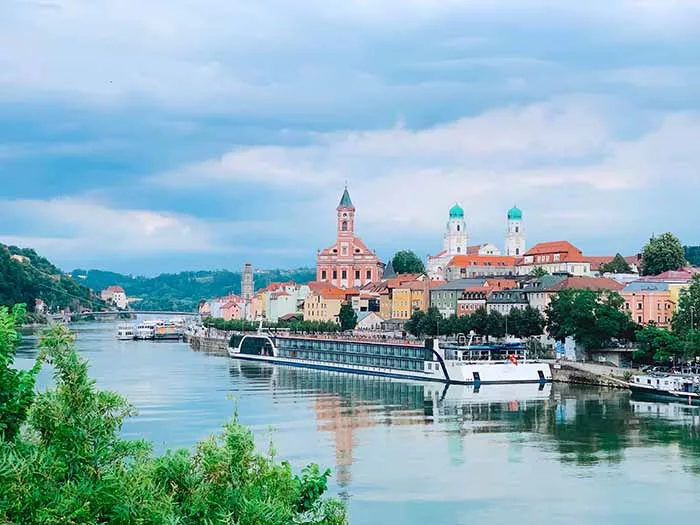
AmaWaterways has evolved rapidly alongside the need for a more sustainable approach to cruising with their modern river fleet incorporating innovative fuel-efficient engines, microfiltration, and energy-saving LED lighting. In recent years, AmaWaterways have earned Green Award certification for the positive environmental impact of their ships, waste management and pollution prevention. AmaWaterways’ newest Europe-based river ship, AmaMagna , has a 10-engine configuration installed to help reduce fuel consumption by up to 20%.
Other eco-friendly practices include:
- The use of recyclable water containers made of renewable resources
- Reduction in single-use plastics
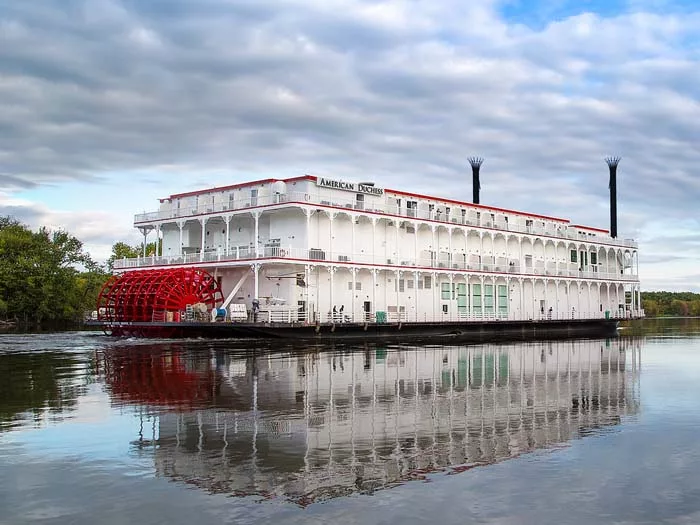
The American Queen Steamboat Company ‘s commitment to environmental stewardship led the river cruise operator to become a member of the Passenger Vessel Association ‘s Green WATERS programme in 2017. They have also worked in partnership with the United States Geological Survey and the Mississippi River Cities & Towns Initiative to monitor water temperature and pollution levels.
- The installation of hydration stations to fill reusable drink-ware
- Recycling food and cooking oil wastage – as a company, American Queen recycled approximately 1,250 gallons of oil in 2019
Since the early 1990s, Aurora Expeditions have led the way in sustainable cruising. The introduction of Greg Mortimer in 2019 started a revolution regarding how the world’s cruise operators approach sustainability from a design perspective. Their innovative approach – purchasing carbon credits and reducing fuel consumption by up to 60% – has seen Aurora Expeditions classified as 100% carbon neutral. The next stage for Aurora is to achieve B CORP certification by 2023.
- The use of eco-friendly products and cleaning equipment
- Sustainable food programme scheduled for later in the year
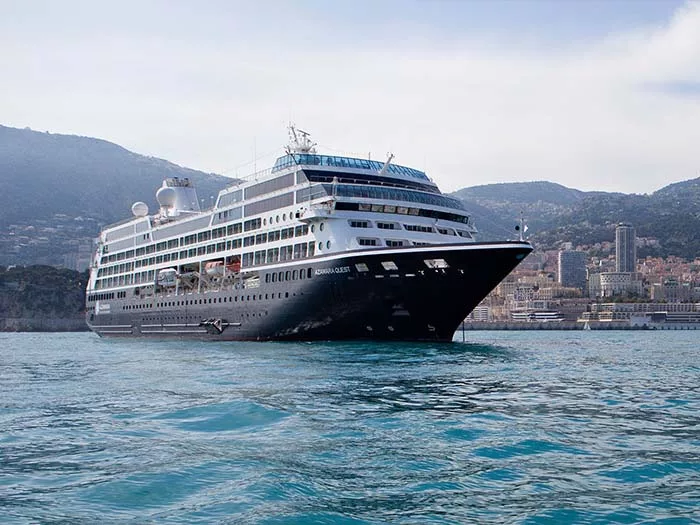
Azamara Cruises has improved its environmental footprint by teaming up with the World Wildlife Fund . As part of Azamara’s commitment to helping protect and conserve our oceans and marine life, the sale of WWF-related merchandise in the ship’s onboard boutiques is donated directly to the organisation to support its ongoing conservation work.
- Azamara aims to reduce the environmental footprint by helping marine life and raising awareness with separate marketing campaigns
Carnival Cruises
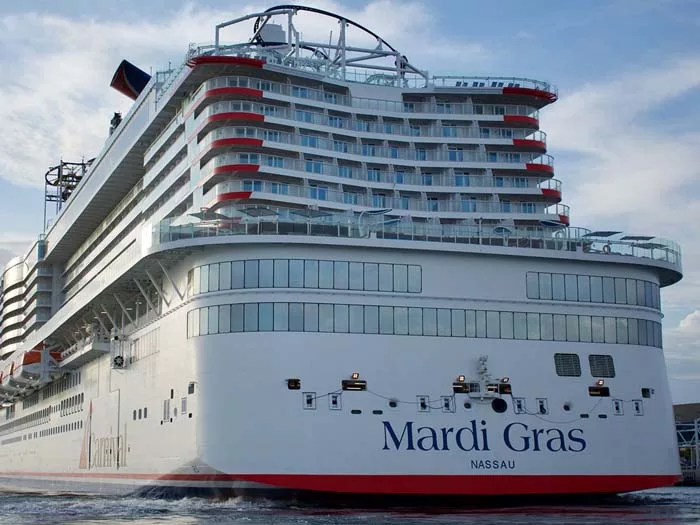
Carnival Cruises has continuously improved its fleet’s carbon footprint by using greener fuel throughout its operations since Mardi Gras became the first LNG-Powered vessel in North America in 2020. Carnival has since reduced its carbon rate by 23.4% and has begun switching the fleet from marine diesel fuel to the more efficient alternative, reducing its carbon emissions by 20%.
- The company aims to reduce their CO2e emissions by 40% by 2030
- Carnival aims to achieve net carbon-neutral ship operations exceeding IMO’s goal of 50% absolute emissions reduction by 2050
- They are retiring less efficient ships throughout the fleet
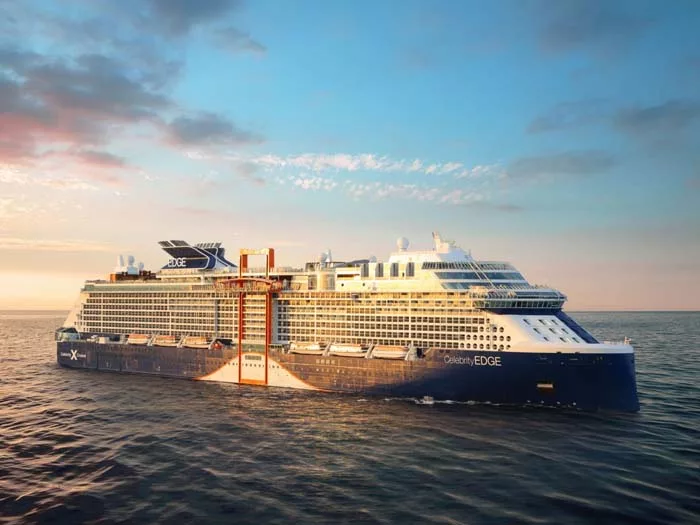
Celebrity Cruises have installed LED lighting throughout their fleet, which requires 80% less energy, generates 50% less heat and reduces energy consumption. Additionally, all Celebrity vessels are equipped with Common Rail Diesel Engines, reducing NOX emissions at all engine loads. The Solstice-series ships are equipped with solar power technology to help reduce the consumption of energy derived from fossil fuels.
- Celebrity Cruises have installed high-efficiency appliances throughout the ship to minimise climate change and reduce their energy load
- Window films that are specially glazed prevent solar heat from penetrating, reducing the amount of air conditioning needed to cool the ship and saving energy
- They installed water-reduction technology throughout their fleet to reduce the use of water-producing equipment that consumes fuel or electricity
- New silicone paints are on the hull, reducing the energy needed to travel through water
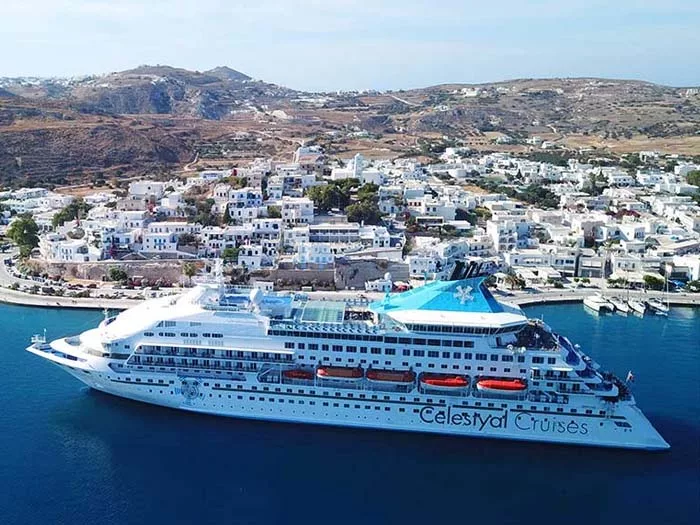
Celestyal Cruises has reduced its CO2 emissions by 4,500 tonnes and has cut its fuel consumption by 5% to contribute towards improving its carbon footprint. In addition, Celestyal has reduced onboard waste by 15% and continues to monitor what they can do in the future to increase sustainability.
- Desalinating seawater to cover 50% of onboard needs
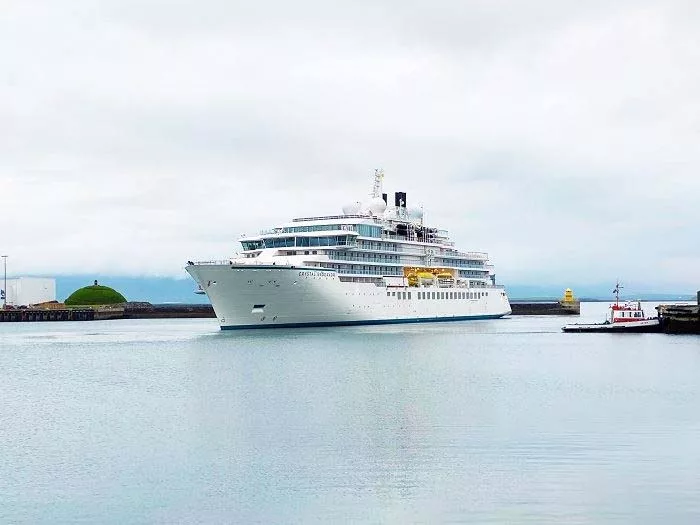
Crystal Cruises is another cruise line to hold the Green Award certification for their river ships. They have recently installed LED lighting across the fleet to improve their environmental footprint. Furthermore, each vessel features a diesel-electric power plant that helps reduce fuel consumption and connects to shore power. Going forward, they aim to minimise waste and reduce the consumption of water and natural resources.
Crystal Cruises’ new purpose-built expedition ship, Crystal Endeavor , is equipped with advanced positioning technology to ensure underwater ecosystems and reefs are not damaged. Furthermore, “biosecurity” screenings occur before and after every wilderness excursion to prevent pathogens from spreading from one site to another.
- Increase sustainable sourcing throughout the entire fleet
- Advanced waste-water treatment systems
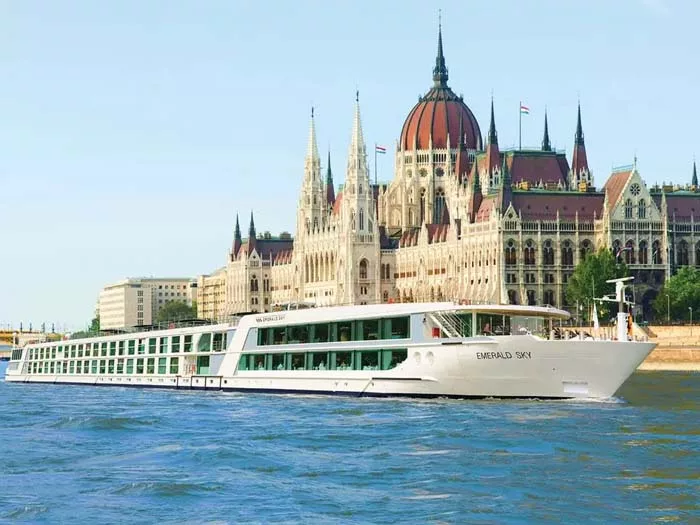
Emerald Cruises use ship-to-shore technology to connect to land-based electricity providers while in port. In particular, one of their river ships, Emerald Harmony, has eliminated the use of all single-use plastic and replaced them with sustainable alternatives, from complimentary refillable bottles and filtered water stations to refillable toiletries in suites. Additionally, all their ocean & river vessels include state of the art sewage treatment plants with membrane filters.
- All engines comply with the strictest EU rules for inland waterways ships
- Emerald no longer uses pre-packaged food, plastic bags or straws
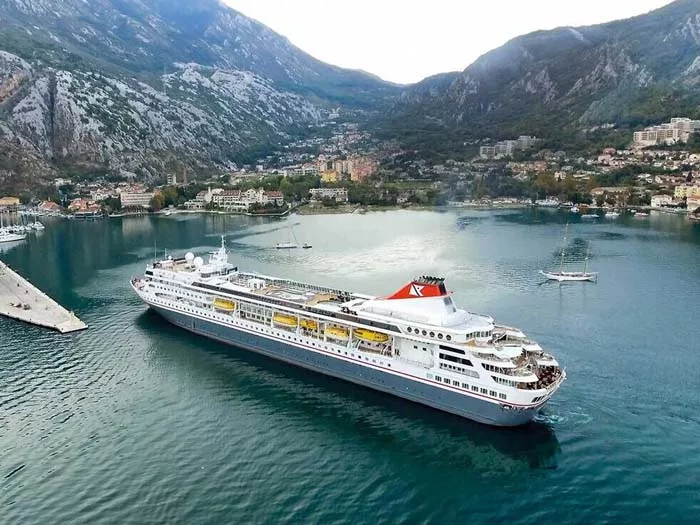
Fred Olsen strives to improve their carbon footprint by complying with all international policies and taking steps to exceed those policies whenever possible. Their ocean vessels use a mix of low sulphur fuel oil and marine gas oil, reducing overall fuel consumption throughout. In addition, Fred Olsen has removed all single-use plastic as a company, replacing it with more sustainable alternatives.
- All onboard waste is sent to an onboard centre dedicated to safe waste disposal and recycling
- All printed marketing communication is on responsibly sourced FSC approved paper
- New linen bags have replaced plastic laundry bags
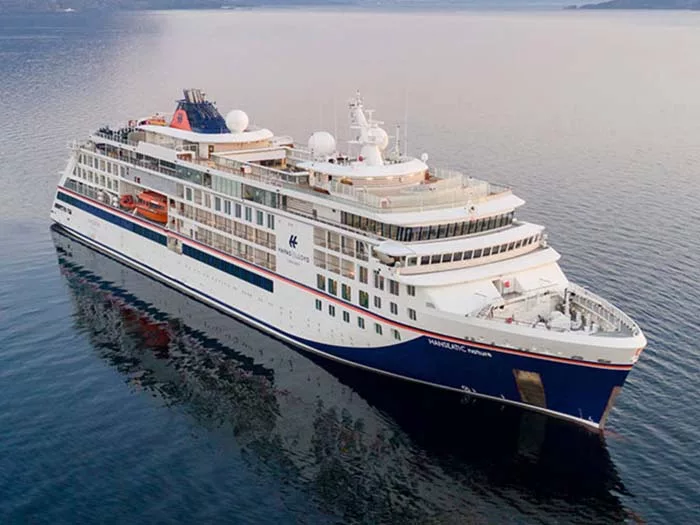
Hapag-Lloyd Cruises have installed SCR catalysts on their latest expedition ships ( Hanseatic Inspiration and Hanseatic Nature), which have helped reduce nitrogen oxide emissions by almost 95%. The esteemed German operator has also equipped vessels with a PROMAS rudder alongside low-pollutant marine gas oil. This unique propeller improves drive-in efficiency and consumes up to 18% less fuel.
- Optimising energy consumption beyond the ships’ engines through LED lighting
- Plastic waste is collected separately onboard the vessels and recycled on land
- Using sustainable alternatives to plastic – the kayaks onboard their new expedition ships are made from HTP
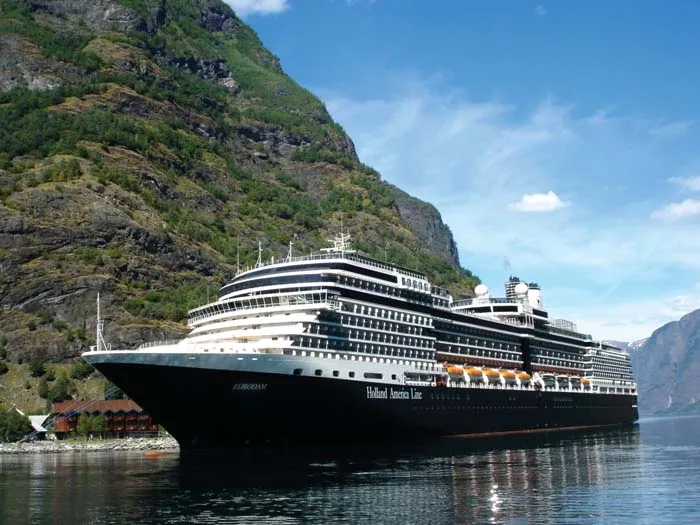
Holland America is committed to reducing, reusing and recycling across the entire fleet. They are currently transitioning to alternative fuels, investing in new low-carbon or zero-carbon emission technologies, and developing and installing advanced air quality systems. As a company, they are committed to reducing food waste and are installing biodigesters on their ships to help reduce their environmental footprint.
- Holland America aspires to achieve 100% fleet-shore-power connection capability and expand alternative fuels strategy across LNG programme and battery, fuel cell and biofuel capabilities by 2030
Hurtigruten Cruises / Hurtigruten Expeditions
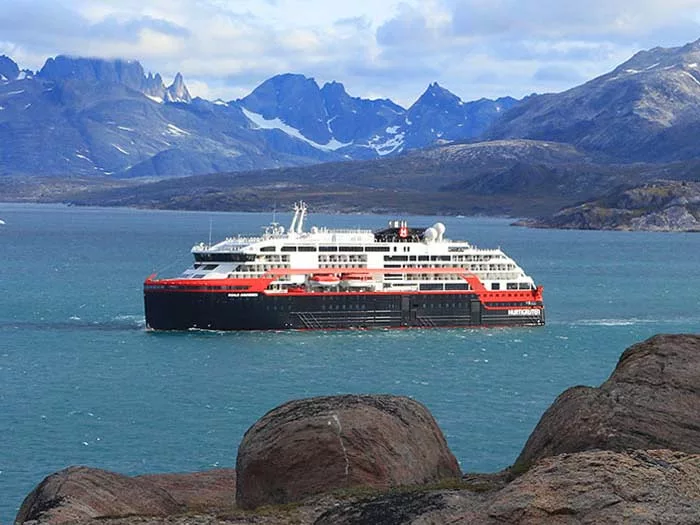
Hurtigruten built the world’s first hybrid-powered cruise ships in 2018 ( Roald Amundsen ) and 2020 ( Fridtjof Nansen ). The vessels used green technology such as battery packs, heat recovery systems and new hull designs to reduce more than 20% of carbon emissions. The ships also reuse heat from the engines to warm the onboard hot water tanks, saving the power equivalent of 6,700 households per year.
- Hurtigruten stopped using heavy fuel oil over a decade ago
- Encourages guests not to have daily towel or bed sheet changes
- Microplastic-made fleeces are not for sale in the onboard gift shop, only natural wool clothing
- All guests are given high-quality reusable bottles, saving at least 1,000 bottles per day
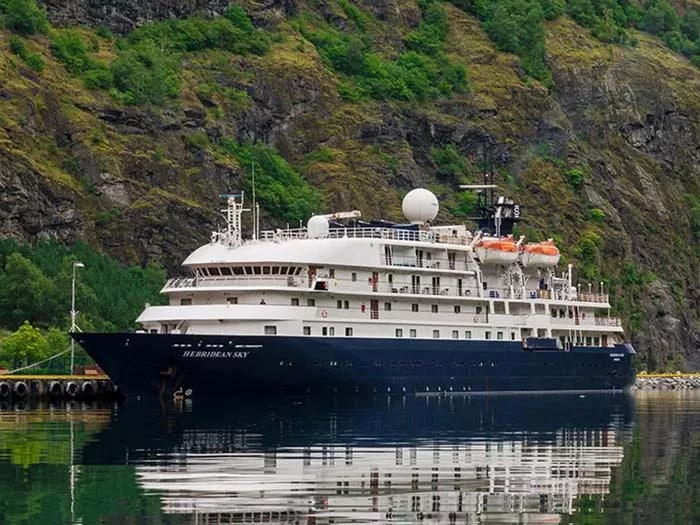
Noble Caledonia provides refillable water bottles on their ships to reduce plastic use. As an expedition cruise line, they are heavily involved in helping to clear the plastic pollution from Aldabra’s turtle nesting beaches and tortoise grazing areas, where at one point, 25,750 kilograms of marine debris were removed over five weeks by a team of 12 people.
- Noble Caledonia operates beach clean-up days aboard their ships and conducts a beach clean-up of plastic and fishing gear. The waste is then returned to the vessel for disposal at the next port.
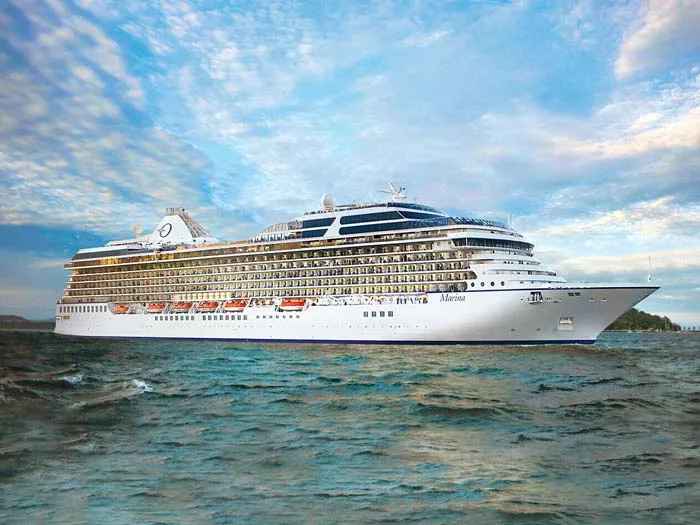
Oceania Cruises have eliminated several million single-use plastic bottles per year from onboard use and instead provided guests with refillable keepsake bottles. In addition, over 80% of self-produced water is used onboard across the fleet. Oceania previously purchased 3-million tons of carbon offsets, which is a step closer to achieving their aim to become carbon neutral. They are currently working to reduce their CO2 emissions rate and increase sustainable sourcing.
- Aiming for a 40% reduction in industry-wide carbon emissions rate by 2030
- All vessels on order will have cold-ironing capabilities
- Advanced Wastewater purification systems have been installed across the fleet
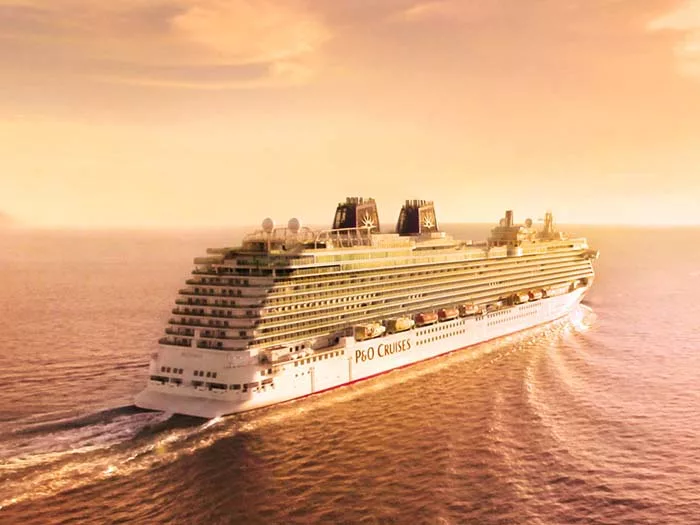
P&O Cruises has committed to a decarbonisation pathway involving significant carbon-efficient technologies and energy efficiency investment. As a result, P&O launched their first LNG powered ship for the British Market ( Iona ), significantly reducing carbon, sulfur dioxide and nitrogen oxides, alongside seeing an overall reduction in the company’s emissions by implementing the relevant technology on all vessels to connect to shore power when in port.
In addition, P&O have been improving their air emissions by installing AAQ Systems across the fleet, removing sulfur compounds and particulate matter from the ships’ engine exhausts.
- P&O are committed to reducing waste and preserving the value of natural resources
- They have reduced and eliminated non-essential single-use plastics, switching to more sustainable alternatives wherever possible
- They are working with suppliers to increase the sustainability of seafood sourcing and have promised never to source seafood that is rated as high impact, threatened or endangered
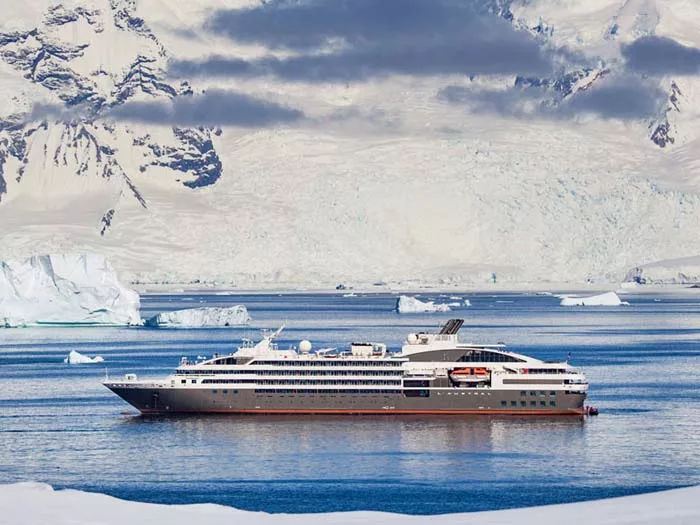
Ponant has offset 150% of its carbon emissions and is the first cruise line to achieve Green Marine certification . Additionally, Ponant recently acquired a 75% reduction in nitrogen oxide emissions by having the ship’s catalytic converters operate continuously. Ponant’s vessels are fitted with electric connections, using shore-to-ship power when docked at suitably equipped ports and are limited to an average speed of 10-knots whilst sailing, reducing fuel consumption by 30%.
In 2022, Ponant launched its first hybrid polar exploration ship powered by liquified natural gas and electric generators. Le Commandant Charcot also has an onboard scientific research team.
- In 2019, the cruise line became the first to exclude fuel oil and switch to Low Sulfur Marine Gasoil, ten times lower than the maximum
- As of 2022, single-use plastics have been eliminated across the fleet
- 100% of waste is separated and sorted, with 60% being recycled – that compares to the global average of less than 20%
The line is also committed to:
- Ensuring the reuse and traceability of all waste by 2025
- Reducing carbon emissions by 30%, nitrogen oxide by 85% and sulfur emissions by 98% by 2030
- Building an entirely carbon-neutral sailing ship which will launch no later than 2025
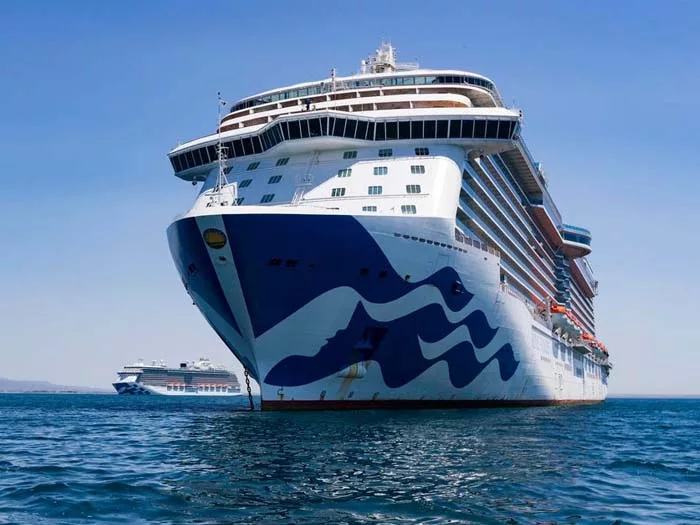
Princess Cruises aims to incorporate environmental practices that set a high standard for excellence and responsibility and help preserve the marine environment. They have achieved and maintained certification to the ‘Environmental Management System’ standard alongside investing in advanced air quality systems technology and the necessary equipment to minimise pollution.
- Committed to further-reducing fuel consumption
- Princess Cruises pioneered shore power in the cruise industry in 2001, allowing them to turn off their diesel engines and to a plug-in power supply in port
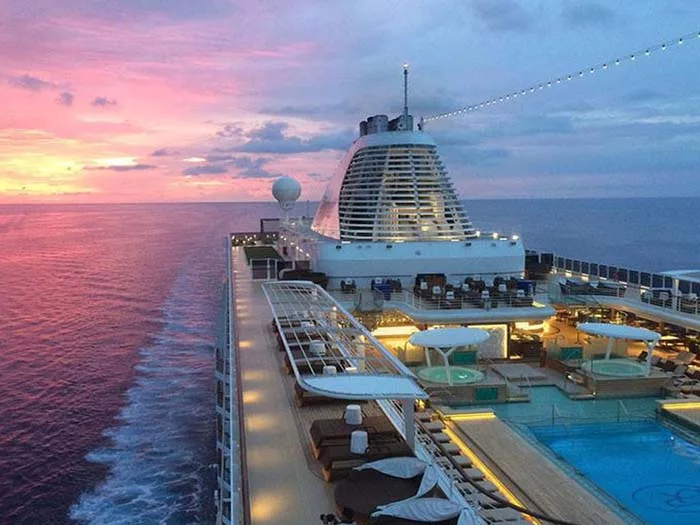
Regent Seven Seas has created a long-term climate action strategy to help achieve its goal of offsetting three million metric tons of carbon dioxide equivalent over three years. They have incorporated a voluntary carbon offset programme and explored more eco-friendly alternative fuels to use on their future voyages. Furthermore, they continue to self-produce approximately 83% of the water used on board to increase their environmental footprint.
- Reducing single-use plastics
- Regent is part of the ‘Sail and Sustain’ Environmental Programme, focusing on reducing environmental impact
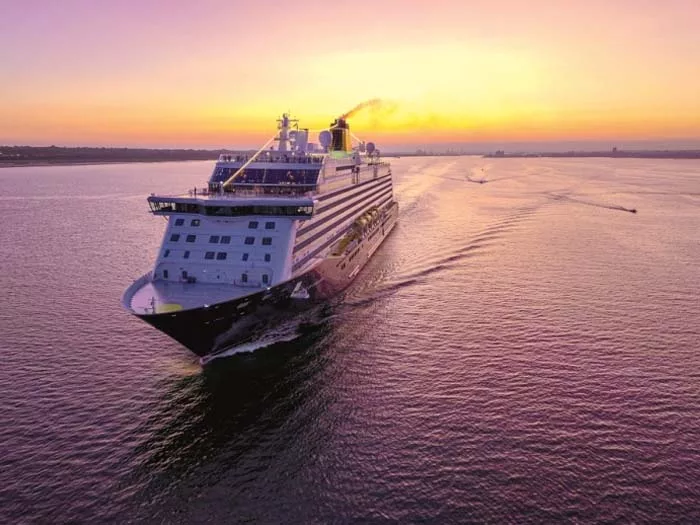
Saga purchases 96% of its electricity from a completely renewable power supply and has further reduced its environmental impact by installing advanced waste management treatment systems, increasing recycling and reducing onboard waste. Additionally, Saga is working with ‘ Travelife Gold ‘ certified hotels, which helps to promote sustainability within the tourism industry and to minimise their impact on the environment.
- Saga’s ships have adopted the single-use plastic policy
- They have set a 30% reduction target for emissions by 2030, aiming to hit below their 2°c temperature rise global target by 2050
Scenic River Cruises / Scenic Ocean Cruises
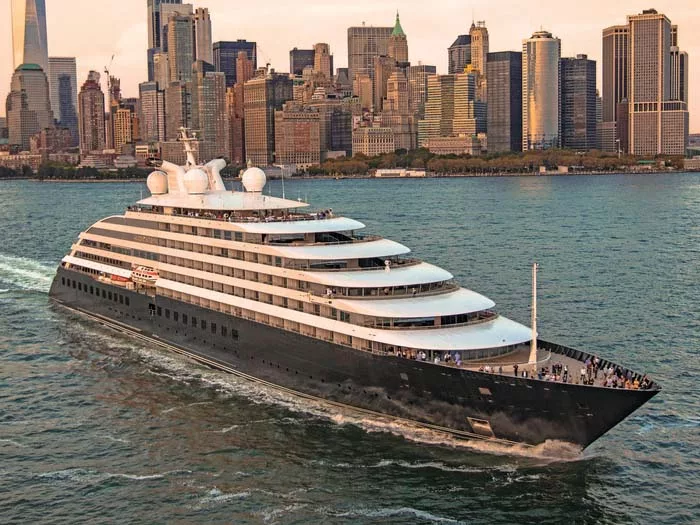
Both Scenic Ocean and Scenic River fleets recently joined ‘ Climate Friendly ™’ and have committed to reducing greenhouse gas emissions by funding renewable energy projects and offsetting any emissions created, effectively becoming a climate-friendly business.
- Scenic purchases carbon credits from Climate Friendly™ to fund renewable energy projects such as wind and solar energy plants
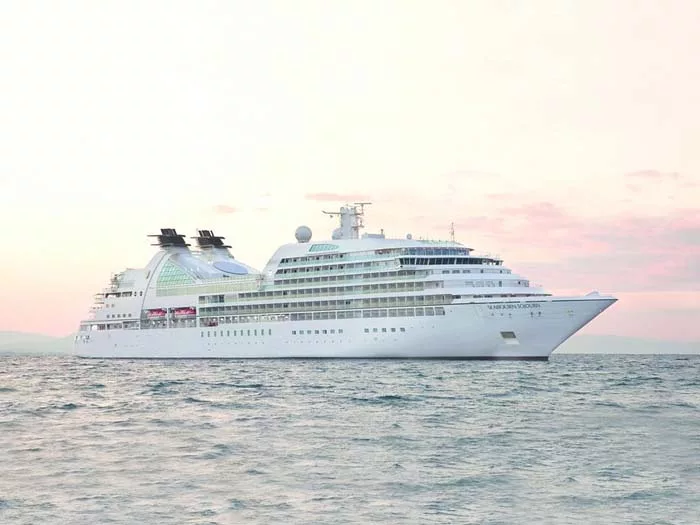
Seabourn has maintained their excellent routine for continuous improvements in critical sectors such as fuel efficiency, greenhouse gas emissions and recycling. As a company, Seabourn continues to improve the quality of its emissions into the air by developing and operating advanced air quality systems across the fleet, capable of reducing sulfur compounds from the ship’s engine exhaust. Additionally, each ship has a full-time Environmental Officer who oversees environmental compliance.
- Reduced single-use plastic, swapping for reusable alternatives such as wood and bamboo
- Guests and crew are provided with reusable water bottles
- Seabourn continues to reduce waste generated by ship operations
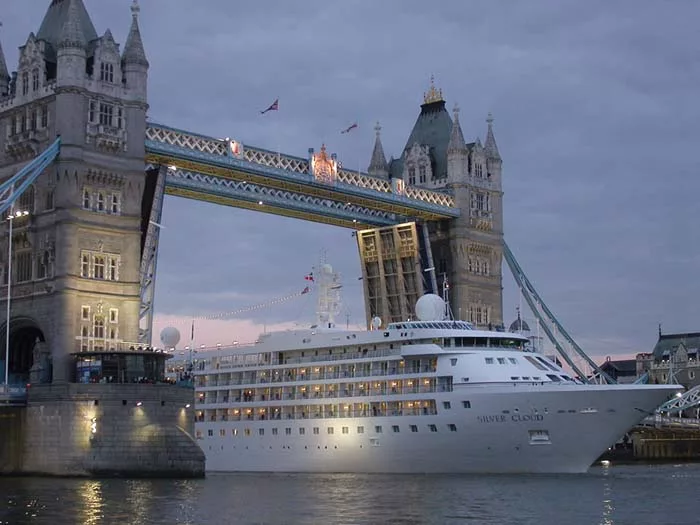
Silversea’s new Nova-class ships – starting with 2023’s Silver Nova – will use hydrogen fuel cell technology to provide 100% of the power while in port, which, if successful, would be a first in the cruise industry. Additionally, the new vessels will use dual-fuel engines with LNG as the primary fuel, batteries, and fuel cells.
Silversea’s purpose-built Galapagos ship, Silver Origin , incorporates environmentally low-impact features to comply with future rules and regulations, including Galapagos National Park Directorate regulations.
- The team at Silversea are working towards making the process of shipbuilding carbon neutral
- They are reducing fuel consumption and exhaust emissions
Star Clippers Cruises
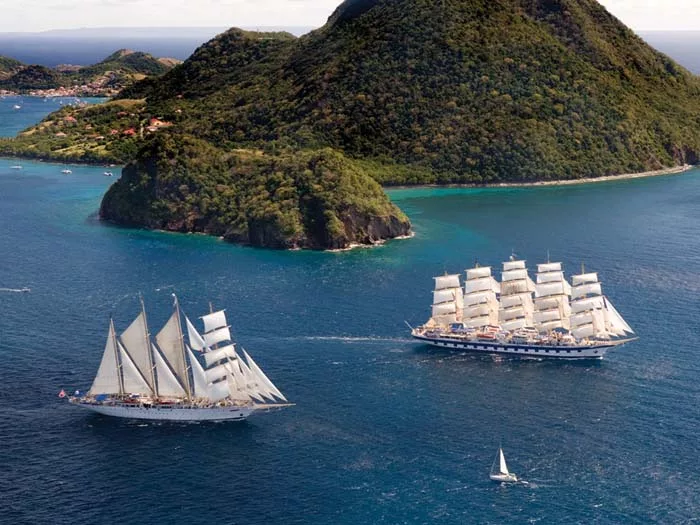
The ships at Star Clippers operate under wind power up to 70% of the time, minimising the use of their auxiliary engines and contributing towards a reduced carbon footprint. The fleet is equipped with smaller, energy-efficient engines designed to exceed new regulations on exhaust gas emissions. Furthermore, Star Flyer was the first ship to be awarded the ‘International Air Pollution Prevention certificate.’
- Using a less polluting fuel grade and utilising high-quality, low-sulphur gas oil
- Only Eco-friendly products are used onboard their vessels
- Onboard recycling, reduced waste and proper disposal of remaining waste
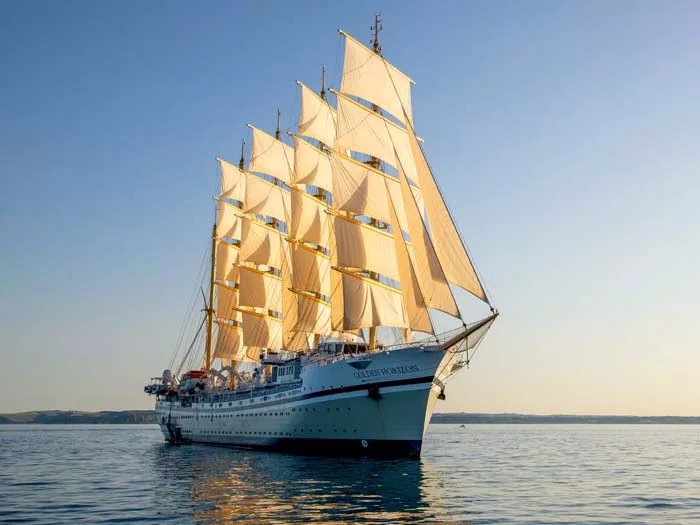
Tradewind Voyages have been working hard towards reducing their CO2 emissions due to sailing without propulsion. Going forward, as a company, they are focused on using more efficient energy systems and eco-friendly fuels, reducing Nitrogen Oxide and Sulphur Oxide levels.
- Tradewind Voyages are reducing single-use plastics
- The feathering mode of ships’ propellers reduces the drag resistance through the water, increasing wind optimisation
- The introduction of innovative water usage systems
- Reduction in food waste
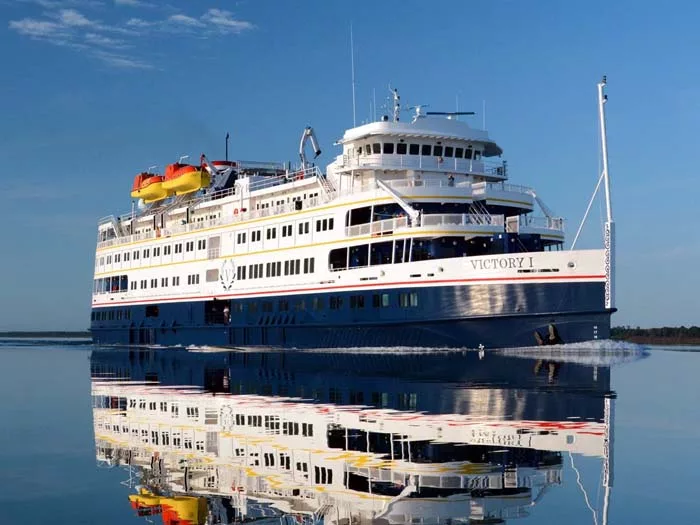
Victory Cruise Lines have recently installed the Ulstein X-BOW on one of their ships, Ocean Victory , allowing the vessel to quietly glide through the waves with minimal vibration, reducing fuel consumption by up to 60%. Furthermore, all vessels have four diesel and two electro engines, reducing fuel consumption and allowing them to maintain Zero Emission Day capabilities that keep Alaska’s air and water clean.
- Stabilisers have been implemented throughout the fleet, minimising the necessity of dropping anchor and protecting seabeds
- Marine biologists, scientists and naturalists from the Department of Marine Biology at California Polytechnic State University are on board to lead excursions and host lectures to guests and fellow crew members
Viking Ocean Cruises / Viking River Cruises
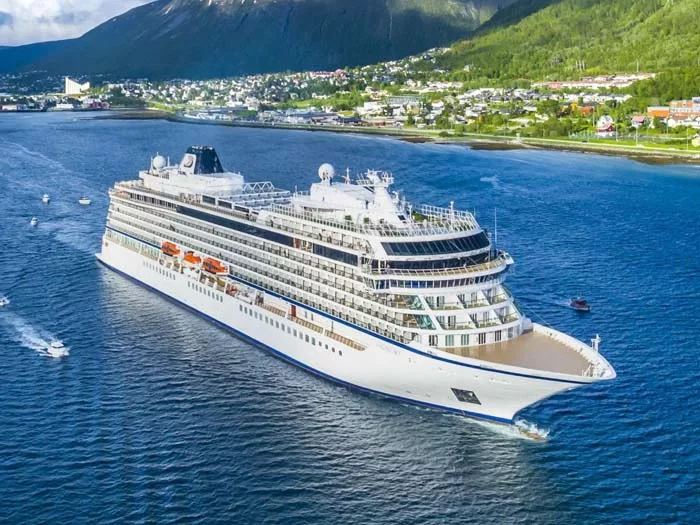
Viking has focused on reducing its carbon footprint across its ocean and river fleets, reducing their fuel consumption and greenhouse gas emissions by 40%.
The ocean ships have an energy-efficient hull, propeller and rudder arrangements alongside efficient engines with heat recovery systems.
Viking’s river vessels, Viking Legend and Viking Prestige, are fitted with diesel-electric hybrid engines, which reduce fuel consumption by 20% compared to regular diesel vessels. Additionally, both ships boast solar panels to increase their energy efficiency.
- Viking owns a higher energy efficiency design index that exceeds the International Maritime Organization requirements for 2025 by almost 20%
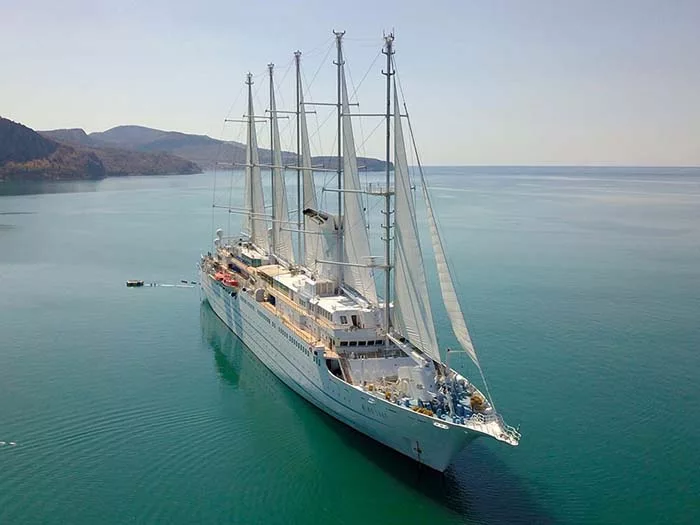
As a company, Windstar has kept up with the formulation and maintenance of environmental management systems, therefore achieving an ISO 14001 certification. They have been busy reducing their ecological footprint and have recently installed eco-friendly LED lighting throughout, already using 90% less energy. In addition, all vessels have had stabilisers containing heavy metals removed to reduce CO2 emissions by 50%.
Whilst using the sails in tandem with the engines, fuel consumption is significantly reduced compared to when the engines are the sole operator.
- Converted to 100% recyclable packaging
- Windstar uses environmentally friendly materials onboard and within the ship’s design

Request a Brochure
Enter your details below or call us on 0800 008 6677
Enquire Now
Privacy overview.
Sustainability at the heart of our business
Our purpose in this world is to protect and save lives. A natural extension of this mission is to make our contribution to protecting the planet from global warming and other human impacts on our environment.
Efforts in support of a sustainable environment are a natural extension of the values the company has stood for since our founding in 1960. We are responsible, engaged and globally oriented in everything we do, including when doing our part to reduce climate change.
Our ambition
We have set ambitious goals for sustainability. By 2030 at the latest, we will achieve a balance between the amount of carbon dioxide we emit and the amount by which we reduce global emissions. In fact, we expect to achieve carbon neutrality even sooner.
Our approach
ESG – Environment, Social and Governance – is gaining traction as a more transparent and measurable way of looking at sustainability and we have formed a comprehensive ESG strategy as core to the purpose of our company.
With a structured ESG approach - rooted in the 10 principles of the UN Global Compact and the 17 Sustainable Development Goals formulated by the United Nations - we want to implement these actions throughout our organization and value chain, including suppliers and partners.
SUSTAINABILITY IN NUMBERS
All standards under one global ISO Umbrella
Employee engagement score (82% in 2022)
Training academies
Our focus areas
Read more about our strategy, ambitions and governance in our sustainability reports.
VIKING sustainability report 2023
Sustainability report 2023, bæredygtighedsrapport 2023, previous sustainability reports.
2022 English | Danish
2021 English | Danish
2020 English | Danish
2019 English | Danish
2018 English | Danish
2017 English | Danish
2016 English | Danish
2015 English | Danish
2014 English | Danish
2013 English | Danish
2012 English | Danish
2011 English | Danish
Cruise operator Viking prices IPO within range to raise $1.54 billion
- Medium Text

Sign up here.
Reporting by Echo Wang in San Francisco and Mrinmay Dey in Bengaluru; Editing by Anirban Sen, Lisa Shumaker and Sherry Jacob-Phillips
Our Standards: The Thomson Reuters Trust Principles. New Tab , opens new tab

Thomson Reuters
Echo Wang is a correspondent at Reuters covering U.S. equity capital markets, and the intersection of Chinese business in the U.S, breaking news from U.S. crackdown on TikTok and Grindr, to restrictions Chinese companies face in listing in New York. She was the Reuters' Reporter of the Year in 2020.

Markets Chevron
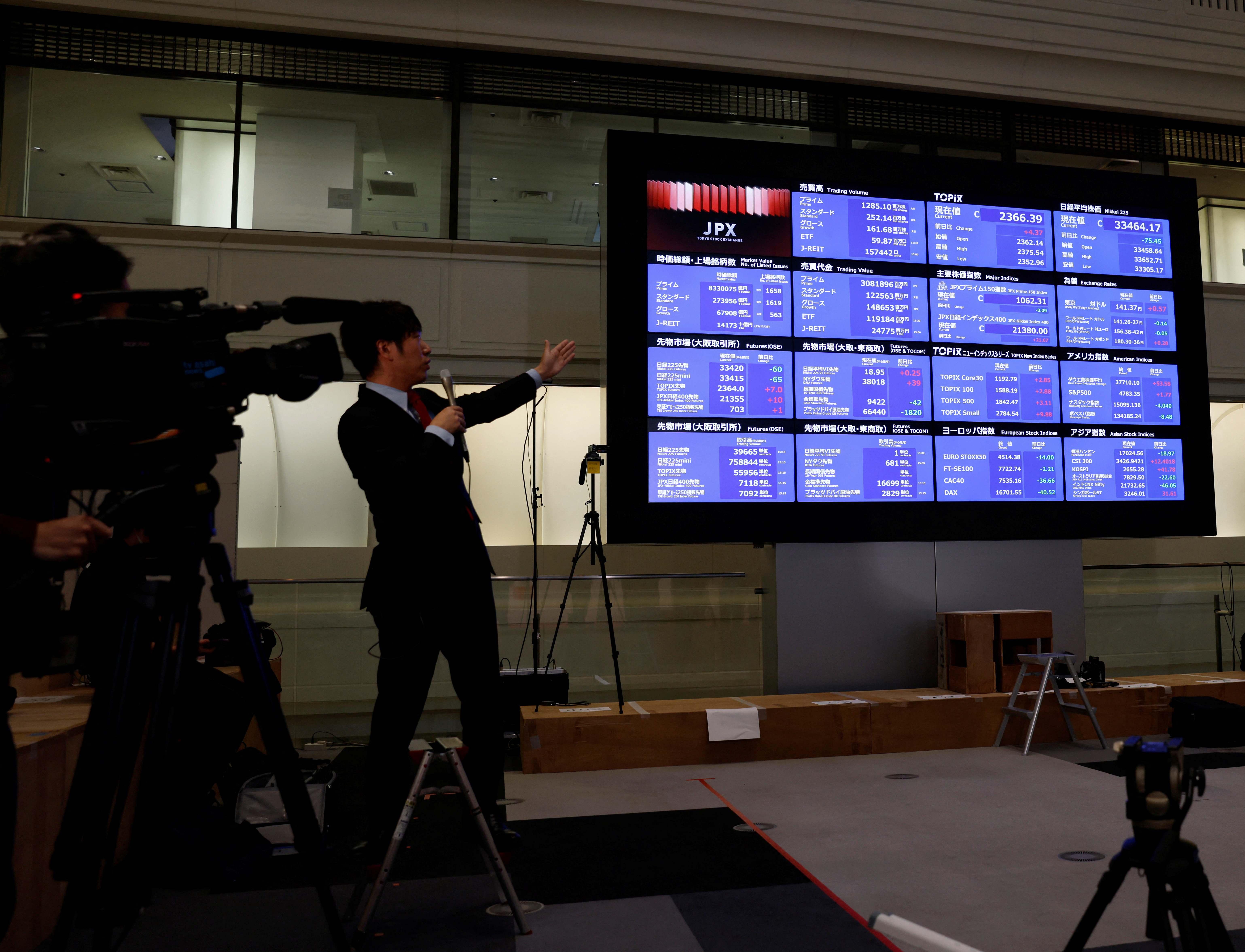
Global hedge funds chase Hong Kong stocks rally, UBS says
Global hedge funds that use an equities long-short strategy are growing increasingly bullish on China, evidenced by the heavy pick-up in their purchases of Hong Kong-listed shares, UBS Group said in a note.

We've detected unusual activity from your computer network
To continue, please click the box below to let us know you're not a robot.
Why did this happen?
Please make sure your browser supports JavaScript and cookies and that you are not blocking them from loading. For more information you can review our Terms of Service and Cookie Policy .
For inquiries related to this message please contact our support team and provide the reference ID below.
Viking IPO: Key Facts Behind the Luxury Cruise Operator’s Billion-Dollar Debut
Sean O'Neill , Skift
April 30th, 2024 at 6:37 PM EDT
Wednesday's IPO will value Viking, an operator of luxury river and ocean cruises, at roughly $10 billion. Leaders in the luxury travel sector will be eyeing the move closely.
Sean O'Neill
Viking , an operator of river and ocean cruises, and a group of shareholders were set to raise more than $1.54 billion in an initial public offering on Wednesday.
When the stock begins trading Wednesday on the New York Stock Exchange under the ticker symbol VIK , the Bermuda-based luxury travel company anticipates that the price per share will be $24.
The company and its shareholders will offer 53 million shares . The IPO placed a roughly $10.3 billion valuation on the company on a fully distributed basis as of the opening bell.
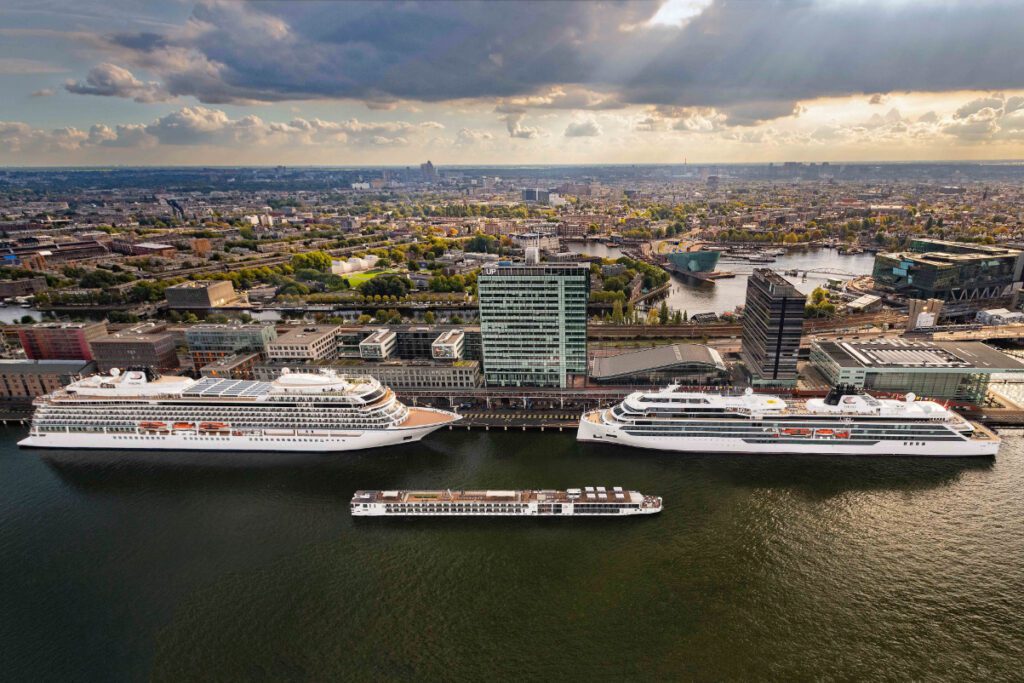
10 Facts About Viking’s IPO and Strategy
- The IPO will enrich chairman, CEO, and co-founder Torstein “Tor” Hagen, 81, who will control a slim majority of Viking shares. The public debut will make Hagen worth roughly $5 billion , according to Bloomberg estimates.
- Hagen began Viking in 1997 with four river ships. Today, the company sails 80 river vessels, averaging 190 passengers each. It also has nine ocean-sailing ships, which typically hold about 900 passengers, making them relatively smaller than traditional ocean vessels. The company has three other vessels, such as those used to cruise the Nile in Egypt.
- Viking wasn’t profitable last year. It reported a $1.86 billion loss in its 2023 fiscal year. But it said that was related to one-time losses. The company reported about $1.09 billion in adjusted EBITDA in its SEC filings.
- The company targets well-off travelers, typically those above age 55. Its average revenue per passenger last year was $7,251.
- The company stands apart from traditional ocean cruise lines. There aren’t water slides or casinos on board. Small children are often banned.
- The company claims it served one out of four luxury cruise-goers on ocean cruises last year out of a market of about 1.1 million. Competitor brands include Oceania, Silversea, Seabourn, and Regent.
- The company claims to have served one out of two river cruise travelers last year, out of a market of 700,000 passengers. Rivals include Grand Circle.
- About 90% of Viking’s guests are from North America. Most of its cruise ship itineraries are in Europe and Antarctica, but it has routes worldwide.
- Viking said it may use some of the capital from the IPO to help expand its offerings to land-based tours and excursions. It will also use some of the capital to pay down its debt, which was $5.4 billion in December.
- Viking has 24 new ships on order, with options for 12 more. It plans to enter China and other markets.
For more on the company, see Viking’s filings with the U.S. Securities and Exchange Commission . Analyst Jess Peterson has crunched other key numbers.
UPDATE: This story was updated with the final pricing for the stock.
Cruise and Tours Sector Stock Index Performance Year-to-Date
What am I looking at? The performance of cruise and tours sector stocks within the ST200 . The index includes companies publicly traded across global markets including both cruise lines and tour operators.
The Skift Travel 200 (ST200) combines the financial performance of nearly 200 travel companies worth more than a trillion dollars into a single number. See more cruise and tours sector financial performance .
Read the full methodology behind the Skift Travel 200.
The Daily Newsletter
Our daily coverage of the global travel industry. Written by editors and analysts from across Skift’s brands.
Have a confidential tip for Skift? Get in touch
Tags: cruise lines , cruises , ipo , IPOs , luxury , river cruise , river cruises , river cruising , viking
Photo credit: Sofa chairs in a public atrium on board a Viking river cruise ship. Source: Viking.
Meet the Norwegian-owned cruise challenger to Carnival and Royal Caribbean that just raised $1.54 billion

Viking had humble beginnings.
The now-listed cruise line was once just a venture by “two guys with two mobile phones and four river ships,” as the company’s CEO, Torstein Hagen, puts it in Viking’s prospectus .
But a lot has changed in 27 years. Now, the Norwegian-owned, Bermuda-based business has a staff of 10,000 catering to guests with a taste for the finer things in life.
The cruise operator, which made its name in European river tours, launched its initial public offering at the New York Stock Exchange on Wednesday. It raised $1.54 billion , according to Reuters, making it the biggest listing in the U.S. this year.
Viking rebounded strongly after the COVID-19 pandemic decimated cruise travel and its public listing comes as luxury consumers are spending more on travel and less on shopping. Some of Viking’s competitors, such as Carnival and Royal Caribbean, have seen record demand for cruises—opening a world of opportunity for the smaller company.
Viking’s beginning
Viking was founded in 1997 by Hagen, who controls most of the company with his daughter, Karine Hagen.
From the start it aimed to give travelers an immersive experience in local cultures as they toured in one of its four river vessels. In the past three decades or so, Viking has expanded its fleet to 92 ships offering three types of experiences via rivers, oceans, and expeditions.
The company has also benefited from some savvy marketing plays: It sponsored PBS Masterpiece series, such as Downton Abbey , and offered themed trips linked to those shows.
Between 2015 and 2023, Viking’s revenue grew at a compound annual rate of 14.4%, outpacing the rest of the cruise industry in the river and luxury ocean segments during this period, the company said in a public filing .
Viking has carved its strategic niche among older, well-off customers, a group it believes is “underserved.” These are not boozy party boats, and there are no kids allowed.
“Our target demographic has greater financial stability, which can make them more resilient to economic conditions and more willing to invest in high-quality travel experiences,” Viking said.
And that’s the space it hopes it can dominate, with the help of its IPO funds.
The Viking founder and road ahead
Hagen didn’t enter the world of cruises till the 1970s.
A physics major in school, Hagen earned an MBA at Harvard University before entering management consulting. He dabbled with entrepreneurship a few times before finally succeeding, Bloomberg reported .
When business for Viking’s river cruises, its first service, began to pick up, Hagen expanded to offer journeys worldwide—from expeditions in Antarctica to river cruises in Vietnam.
Viking is on an expedition of its own now that its shares are traded. Last year, the cruise line hosted close to 650,000 guests and generated $4.7 billion in revenue, up by almost 50% from 2022. Its underlying profits were $1.1 billion for the same period, according to Viking’s prospectus.
The cruise company is still much smaller than rivals like Carnival, Royal Caribbean, and Norwegian. But it’s a global leader in some segments, such as luxury ocean cruises.
Following a strong open, Viking’s market valuation has reached more than $10 billion, putting Hagen’s wealth at $5 billion. As the appetite for luxury travel builds , Viking is ready to ride the wave.
Latest in Lifestyle

Richard Branson says it’s ‘very sad’ when people measure wealth as success and finds being called a billionaire ‘insulting’

Meet the 12-hour school day that will cure Gen Z’s crippling social awkwardness, complete with public speaking lessons and a smartphone ban

Golden Visa chasers helped pump $4.2 billion into Portugal last year—scrapping the scheme probably won’t help locals get on the housing ladder

The financial services gender pay gap in Europe is so large that fewer than one in 10 of the 2,000 highest-earning bankers are female

Unilever and LVMH have one common bright spot—people love spending on beauty, and it’s outshining their other products
Most popular.

Furious Mexican farmers are ripping out water pumps for avocado orchards and berry fields, risking cartel reprisal

Move over, American dream: The goal of many Gen Z and millennial women is now to be a DINK—with dual income and no kids

Peloton, the fallen fitness unicorn, faces a harsh truth despite its shiny new deal with Hyatt hotels: ‘I don’t think they thought [about] what was going to happen post-pandemic’

Starbucks flags unusual phenomenon for ‘disappointing’ sales: It’s too popular with morning commuters

U.S. fishermen poised to harvest billions of baby eels worth $2,000 a pound as authorities battle illegal sales

Tesla slashes its summer internship program to cut costs, as Elon Musk fights to save his $45 billion pay plan

This cruise ship spa has its own 'showstopper' Snow Grotto — and it's free for all guests
Y ou don’t have to bother setting up an ice-filled tub in your garden to partake in the ancient Scandinavian bathing ritual of hot and cold therapies.
Viking Ocean cruises offers a far more civilised way to get in on the trend, with all its ships featuring a swanky Nordic Spa that’s free for all passengers.
Alongside staples you’d expect like a sauna and steam room, this modern wellness centre has its own Snow Grotto (the first of its kind on the seas) filled with manmade snow, which is perfect for a revitalising hit of cold before a dip in the hot tub.
So perhaps it’s no surprise it’s been nominated for an award in wellness (alongside Explora Journeys, Silversea, Emerald Cruises, Amawaterways, Virgin Voyages and Swan Hellenic in the coveted wellness category) in the Sailawaze Excellence Awards in May .
Cruise critic Jorge Oliver called it a ‘showstopper’, while Well Travelled reviewer Jason Dutton-Smith described it as a ‘fascinating addition’ that provides a ‘rejuvenating and rapid cool down’.
There’s a specific order you’re supposed to stick to when it comes to this ritual: start with a dry sauna, steam room or hot spa, then plunge into icy cold before heading back to the warmth and letting your body reacclimatise.
Purported benefits of cold water immersion include ‘speeding up muscle recovery, reducing muscle damage and boosting circulation’ after exercise.
There’s also evidence it can aid better sleep, ease soreness, and shock your central nervous system to make you feel less fatigued.
As well spending a few minutes in the Snow Grotto, visitors to Viking’s Nordic Spa can make use of the splash bucket or cold plunge pool for their chilly fix.
It may seem daunting at first, but knowing there’s a toasty hydrotherapy pool, heated stone lounger, or experience shower waiting for you afterwards should help you get past the initial jolt.
The fact you don’t have to pay to use any of these facilities while on a Viking Ocean trip also sweetens the experience.
While extras like massages and beauty treatments are paid for, access to the spa is totally free — a rare bonus in the cruise world.
Want to win a cruising holiday for 2?
Do you love cruising? Are you an intrepid traveller? Maybe you just like looking at pictures of luxe ships. No matter which, we want you to vote!
Metro has partnered with the Sailawaze Excellence Awards , highlighting the very best in cruising when it comes to sustainability, wellness, entertainment and beyond.
And we need YOU to simply select what you’ve been most impressed by.
The best bit? By voting you’ll automatically be in with a chance of winning a cruise for two worth £2,500.
Say bon voyage to the more traditional categories of 'best large ship' or 'best luxury cruise line' and instead ahoy to innovation, food and drink and showstopping performances.
Vote for your favourite here .
Nominations in the Sailawaze Excellence Awards 2024:
Food & beverage.
Virgin Voyages
Aqua Expeditions
TUI River Cruises
Windstar Cruises
Explora Journeys
Regent Seven Seas Cruises
P&O Cruises
Riverside Luxury Cruises
Emerald Cruises
Amawaterways
Swan Hellenic
Princess Cruises
MSC Cruises
Royal Caribbean
SUSTAINABILITY
AE Expeditions
The Majestic Line
Portsmouth International Port
Hurtigruten
Fred. Olsen Cruise Lines
Oceania Cruises
Havila Voyages
Pandaw Expeditions
Holland America Line
CroisiEurope
Celebrity Cruises
VIVA Cruises
Disney Cruise Line
Saga Cruises
A- Rosa Cruises
ENTERTAINMENT
Carnival Cruise Line
Marella Cruises
COLLABORATIONS
Ambassador Cruise Line
A-Rosa Cruises
Viking prides itself on being different to many operators out there, with no casinos on board its liners, complimentary laundry service, free beer and wine with meals, free Wi-Fi, no charge for alternative restaurants and no photography sales.
Its over-18s-only policy does mean the kids can’t join you on your voyage, but you’ll experience ‘a more cultured style of cruising’ with ‘a sophisticated grown-up feel’ thanks to a roster of activities like watercolour painting, cooking classes and art lectures.
There are a range of routes to choose from, including Scandinavia, the Caribbean and Central America and the Mediterranean. Alternatively, you can go for one of Viking Ocean’s World Cruises or Grand Journeys, combining two or more itineraries or spending months travelling the globe.
It’s not exactly a budget holiday, though. The cheapest option on the Viking site is the eight-day Viking Shores and Fjords trip going from Amsterdam to Berge for £3,590, and round-the-world trips can top £60,000.
But for those looking to travel in style or book a bucket list break where luxury perks don’t cost extra, it could be just the ticket.
If you were wondering who else was nominated in the wellness category of the Sailawaze Excellence Awards (of which Metro is a partner of), we’ve got you.
Swan Hellenic has partnered with physician and author Deepak Chopra to create ‘Explore & Restore’ wellbeing voyages. Here you’ll find Chopra-certified meditation and yoga teachers offer daily private and group sessions with itineraries including Ayurvedic culinary offerings, daily meditation, yoga and breath-work classes.
Silversea has its Otium wellness inspired by the traditions of Ancient Rome, with tailor-made in-suite experiences, including Otium Balcony Experience (first hot chocolate menu at sea, we should add) and Otium Sleeping Experience (pillow menus and signature Otium sleeping scent, yes please). You can also enjoy champagne and caviar 24 hours a day anywhere as you’re pampered in the spa, with 100-minute-long signature treatments.
Virgin Voyages has its Athletic Club – designed like a retro athletic social club – which features a boxing ring, an outdoor active training camp, a basketball court and a cold-pressed juice bar. By night, the catamaran net provides a perfect spot for stargazing.
AmaWaterways Wellness nomination is the AmaMagna: the first river cruise ship to offer a full-sized pickleball court. Onboard classes offer workout classes such as ’champagne yoga’ on selected sailings with the Mekong cruises offering unique wellness activities like tea ceremonies, tai chi, yoga, and guided meditation.
Emerald Cruises has fitness activities including guided hikes and bike rides, plus canoeing and kayaking excursions, with dedicated on board spas and professionally trained treatment therapists. A wellness coach is on hand to provide fitness advice and group lessons, including open-air yoga and water aerobics and a state-of-the-art infrared sauna on Emerald Azzurra and Emerald Sakara is also your wellness mate. The cruises promote space, relaxation, and a more personalised service, with the crew addressing guests by their first names and remembering their favourite drinks.
Finally, Explora Journeys has in-suite apps for guided meditation, morning stretches, sleep-boosting soundtracks and exercise videos, as well as open-air workout facilities and a fitness centre and studio equipped with Pilates Reformers and Technogym equipment. That comes with expert-led retreat programmes for immune boosting and sleep and a spa that features a Finnish sauna, Himalayan salt cave and multi-sensory experience showers.
Do you have a story to share?
Get in touch by emailing [email protected] .
For even more unmissable travel news, features and inspiration in your inbox each week, sign up to Metro's The Getaway newsletter
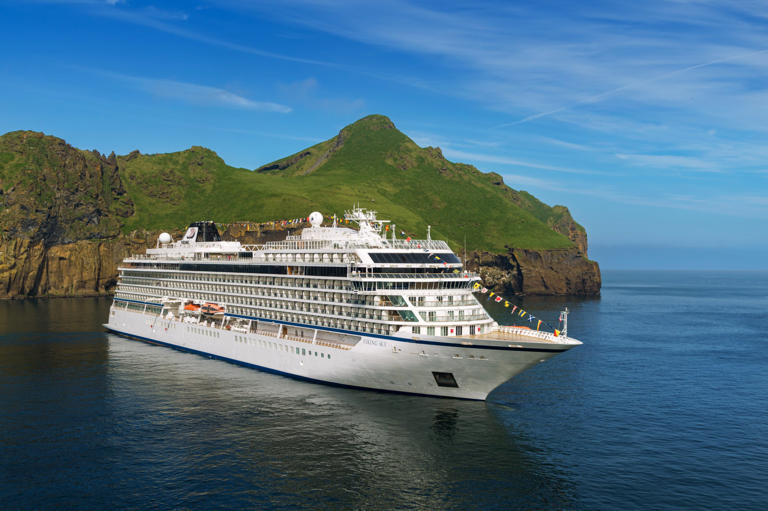

IMAGES
COMMENTS
One important focus area in Viking Line's sustainability work is the optimisation of fuel use through a number of different measures. In the period 2015-2022, we invested more than 6 million euros in this work, and in 2008-2022, we succeeded in achieving a fuel saving of 30% per nautical mile. ... The outsider artist, who loves cruises ...
company, Viking Line Abp, are traded on NASDAQ Helsinki. The company is domiciled in Mariehamn. This is Viking Line Fundamental values Mission We link together the countries around the northern Baltic Sea by providing sustainable and regular ferry service for everyone. Our three basic services are cruises, passenger transport and cargo ...
VIKING LINE SUSTAINABILITY REPORT 2021 4 In 2021, Viking Line conducted services using the vessels Amorella, Gabriella, Mariella, Rosella, Viking Cinderella, Viking Grace and Viking XPRS. Mariel-la was sold in May 2021 and in March 2022, Viking Glory started operating on the Turku-Åland-Stockholm route. Our vessels depart from Åland, Stock -
This is Viking Line Core values vien AB, Viking Rederi AB, OÜ Viking Line Eesti, Viking Line Finnlandverkehr GmbH and Viking Line Buss Ab belong to the Viking Line Group. Mission We link together the countries around the northern Baltic Sea by providing sustaina-ble and regular ferry service for everyone. Our three basic services are cruises, and
Viking Cruises provides river, ocean, and expedition cruises worldwide. The cruise line was founded in 1997 and its current headquarters are in Switzerland. Currently, Viking has a fleet of 8 larger ocean-going cruise ships which carry between 1,400 and 1,530 passengers and crew and 2 smaller cruise ships that each carry 638 passengers and crew.
Sustainability was the buzzword of Seatrade Cruise Global this year -- we break down what the cruise industry is doing and how the changes will affect you ... Viking, for example, has said it will ...
The 378-passenger Viking Octantis, delivered by Fincantieri's VARD in Norway last month, is scheduled to set sail for the first time in early 2022. ... Viking's Head of Science and Sustainability, Damon Stanwell-Smith, said that the cruise line has worked with the Cornell Lab of Ornithology to reduce the likelihood of harming birds.
Viking, a luxury line whose passengers tend to be wealthy and college-educated, ... the vice president of sustainability at MSC Cruises. "Nothing is off the table for us for now as we look for ...
"This is the closest most will get to being on a working research vessel," Viking's head of science and sustainability said of the new expedition ship. Viking's new cruise ship is basically a ...
Sustainability Report 2021 For a safe and responsible world. Side 2. Link kopieret til udklipsholder. Download PDF fil. ...
This 130-year-old Norwegian adventure travel company incorporates a sustainability ethos at its core. A green-energy leader, Hurtigruten sidelined HFO for its small-ship fleet over a decade ago ...
The announcement is the latest in a series of major fleet expansion moves for Viking. In March the company reported that it had for an order that would see the delivery of six new cruise ships by ...
Call Viking at. *Free airfare on select departures of Grand European Tour, Capitals of Eastern Europe, Lyon Provence & the Rhineland and European Sojourn, plus select China, Panama Canal, Hawaii, Canada, Mississippi River, Great Lakes and Antarctica itineraries. Viking has partnered with world-leading cultural & scientific institutions.
Follow recent announcements and milestones from Viking. *Free airfare on select departures of Grand European Tour, Capitals of Eastern Europe, Lyon Provence & the Rhineland and European Sojourn, plus select China, Panama Canal, Hawaii, Canada, Mississippi River, Great Lakes and Antarctica itineraries.
Viking, a well-known name in cruising and industry leader, focuses on sustainability. In particular, they have a notable new ship making impressive advancements in this arena. The Viking Octantis is an expedition ship with cruise sustainability as a main focus of its design. It will sail in the Arctic and Antarctic.
Developed in coordination with an international team of scientific and medical advisors, the Viking Health & Safety Program is one of the most well-researched and comprehensive COVID-19 prevention and mitigation plans in the travel industry. Frequent quick and easy non-invasive saliva PCR tests for all guests and crew, processed in full-scale ...
The 2022 Cruise Ship Report Card takes a continued hard look at the cruise industry to see if clean cruising is possible and in most cases the answer is still a resounding NO! Friends of the Earth's Cruise Ship Report Card compares the environmental footprint of 18 major cruise lines and 213 cruise ships. View a PDF of the 2022 Cruise Ship ...
Viking Line Sustainability Report 2021 Media. Find your trip Find your trip Viking Line Cargo Viking Line Cargo Services Booking and contact ... Viking Line Abp, org. nr. 0144983-8, PB 166, AX-22101 Mariehamn, Åland, Finland ...
Launched European river cruises for Chinese customers in 2016, expanding the business to 20,000 customers a year in 2019. Purchased KD River Lines in 2000 to expand Viking's European river cruise portfolio, ahead of entering the American market. Founded Viking Cruises in 1997 with the purchase of four river vessels in Russia.
Viking cruises is one liner currently using Bergen as a turning port for some of their cruises. There is still a long way to go before the cruise industry reaches zero emissions. Norwegian actors are nonetheless doing an important job, developing and testing the technologies that are necessary to reach these goals.
Since the early 1990s, Aurora Expeditions have led the way in sustainable cruising. The introduction of Greg Mortimer in 2019 started a revolution regarding how the world's cruise operators approach sustainability from a design perspective. Their innovative approach - purchasing carbon credits and reducing fuel consumption by up to 60% - has seen Aurora Expeditions classified as 100% ...
Our approach. ESG - Environment, Social and Governance - is gaining traction as a more transparent and measurable way of looking at sustainability and we have formed a comprehensive ESG strategy as core to the purpose of our company. With a structured ESG approach - rooted in the 10 principles of the UN Global Compact and the 17 Sustainable ...
The IPO raised $1.54 billion based on 64.04 million shares sold by the company and its existing investors. It infers a valuation of $10.35 billion on Viking, making it the biggest U.S. stock ...
April 30, 2024 at 3:28 PM PDT. Listen. 3:43. Viking Holdings Ltd. priced its initial public offering near the top of a marketed range to raise $1.54 billion for the luxury cruise operator and two ...
are cruises, passenger transport and cargo transport. Our unique expertise in combining these services generates customer and business benefits. ... 6 VIKING LINE SUSTAINABILITY 2019 VIKING LINE SUSTAINABILITY 2019 7 Results for the year The results trend for the financial year was better than in 2018. I am especially pleased with the
Wednesday's IPO will value Viking, an operator of luxury river and ocean cruises, at roughly $10 billion. Leaders in the luxury travel sector will be eyeing the move closely. Sean O'Neill. Viking ...
Viking is on an expedition of its own now that its shares are traded. Last year, the cruise line hosted close to 650,000 guests and generated $4.7 billion in revenue, up by almost 50% from 2022.
Viking Cruises turned European river travel into a lucrative business by catering to affluent older Americans interested in culture, art, and history. As Viking's tagline says, "Exploring the ...
The cheapest option on the Viking site is the eight-day Viking Shores and Fjords trip going from Amsterdam to Berge for £3,590, and round-the-world trips can top £60,000.